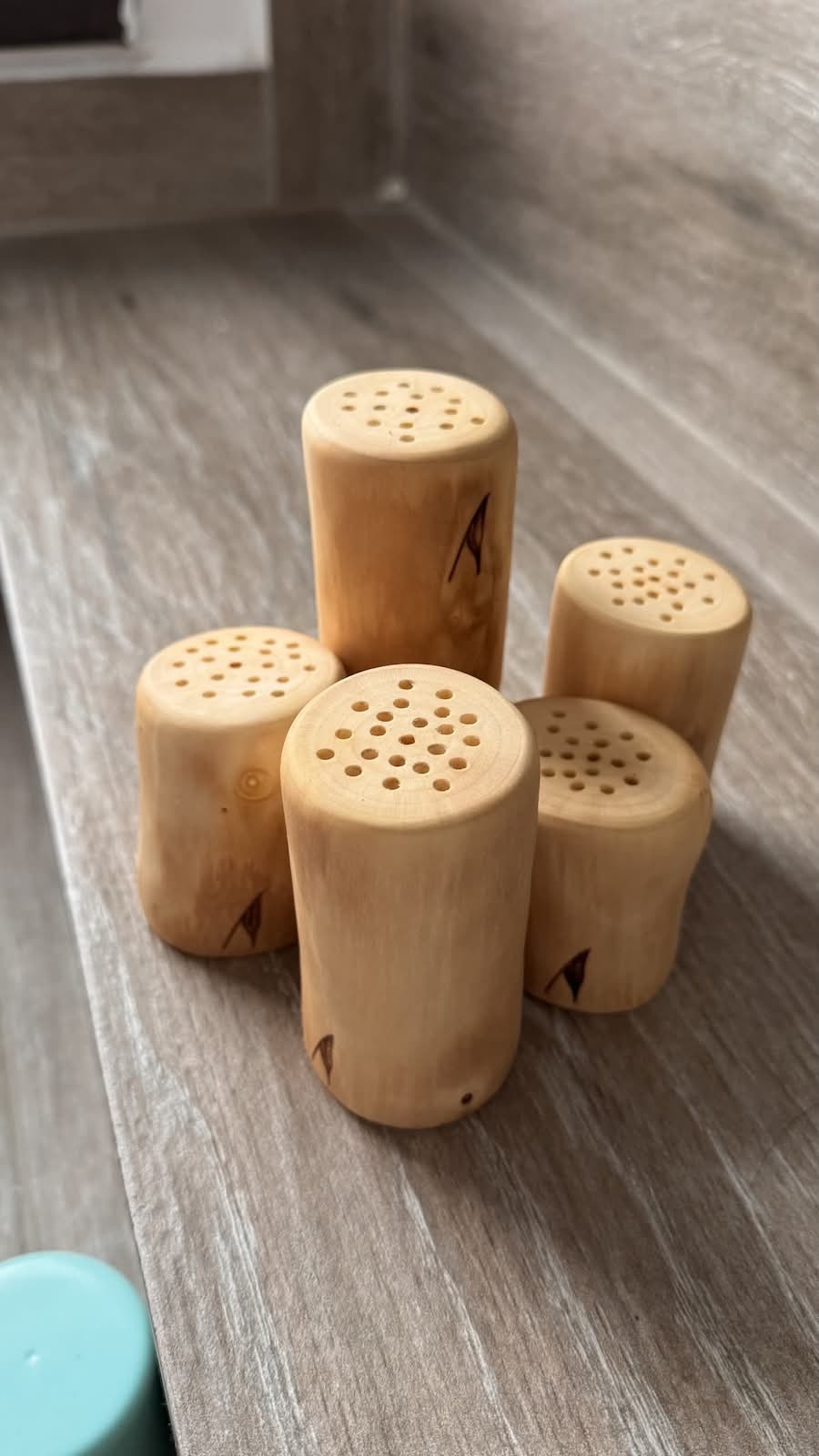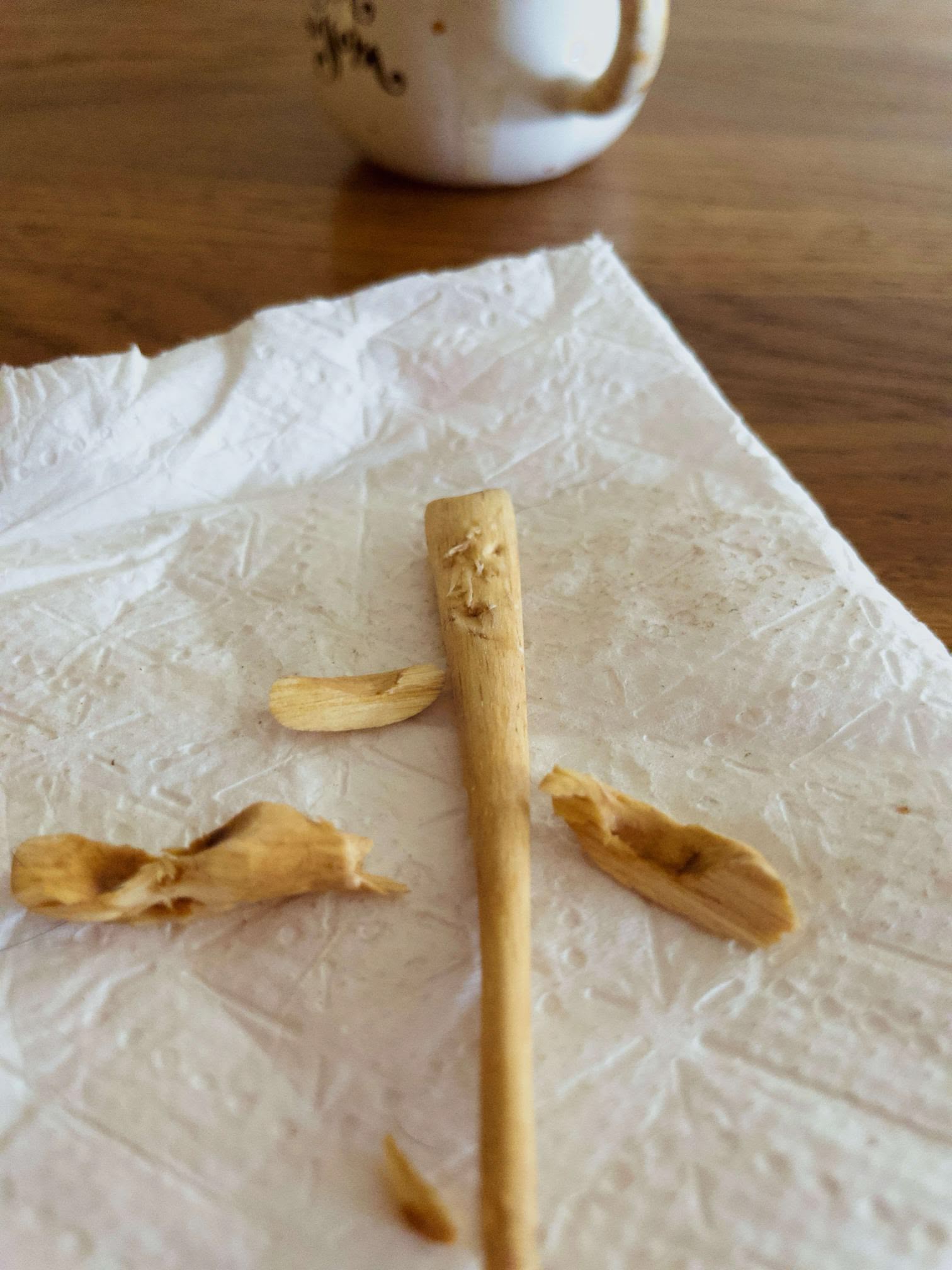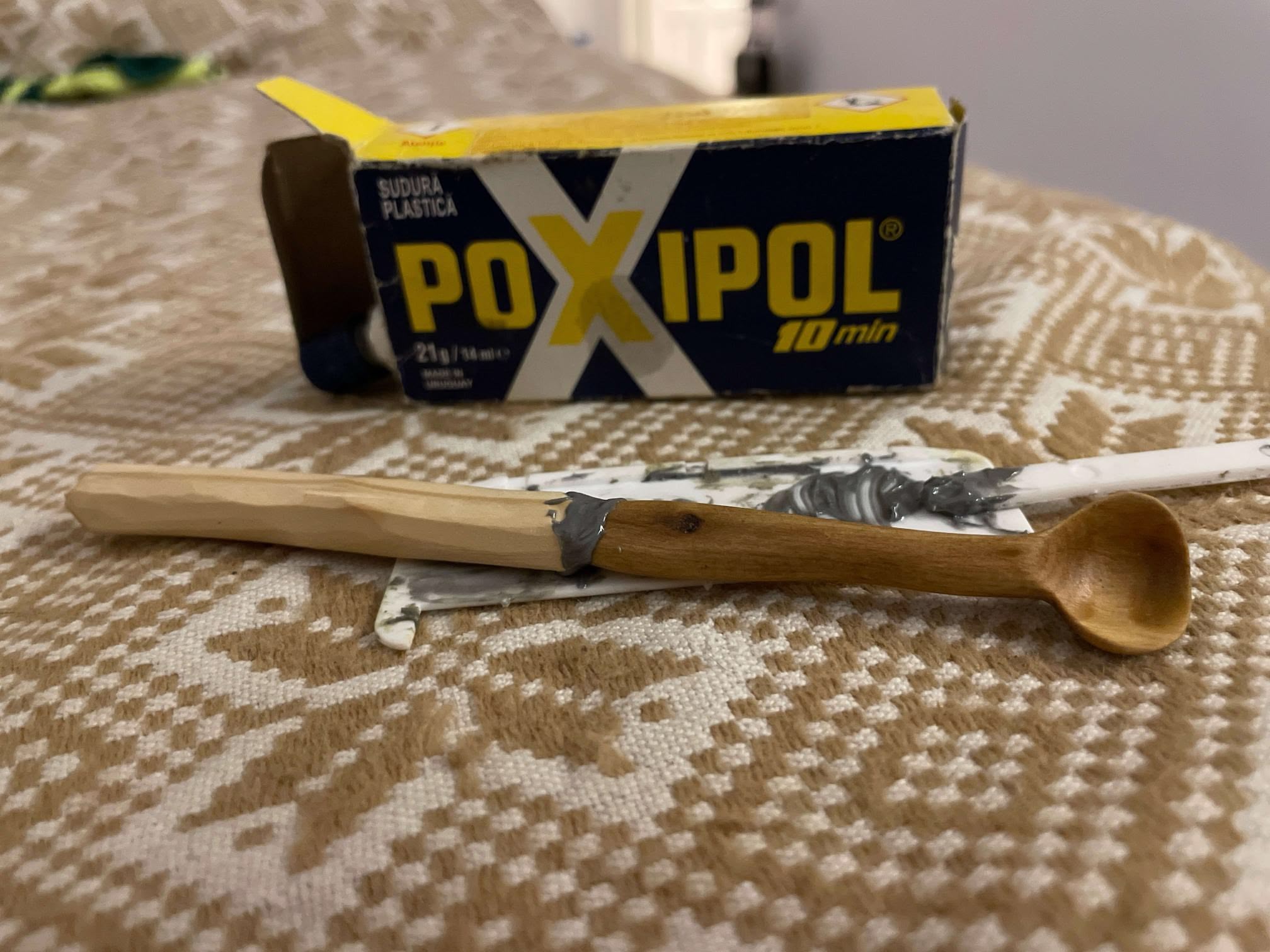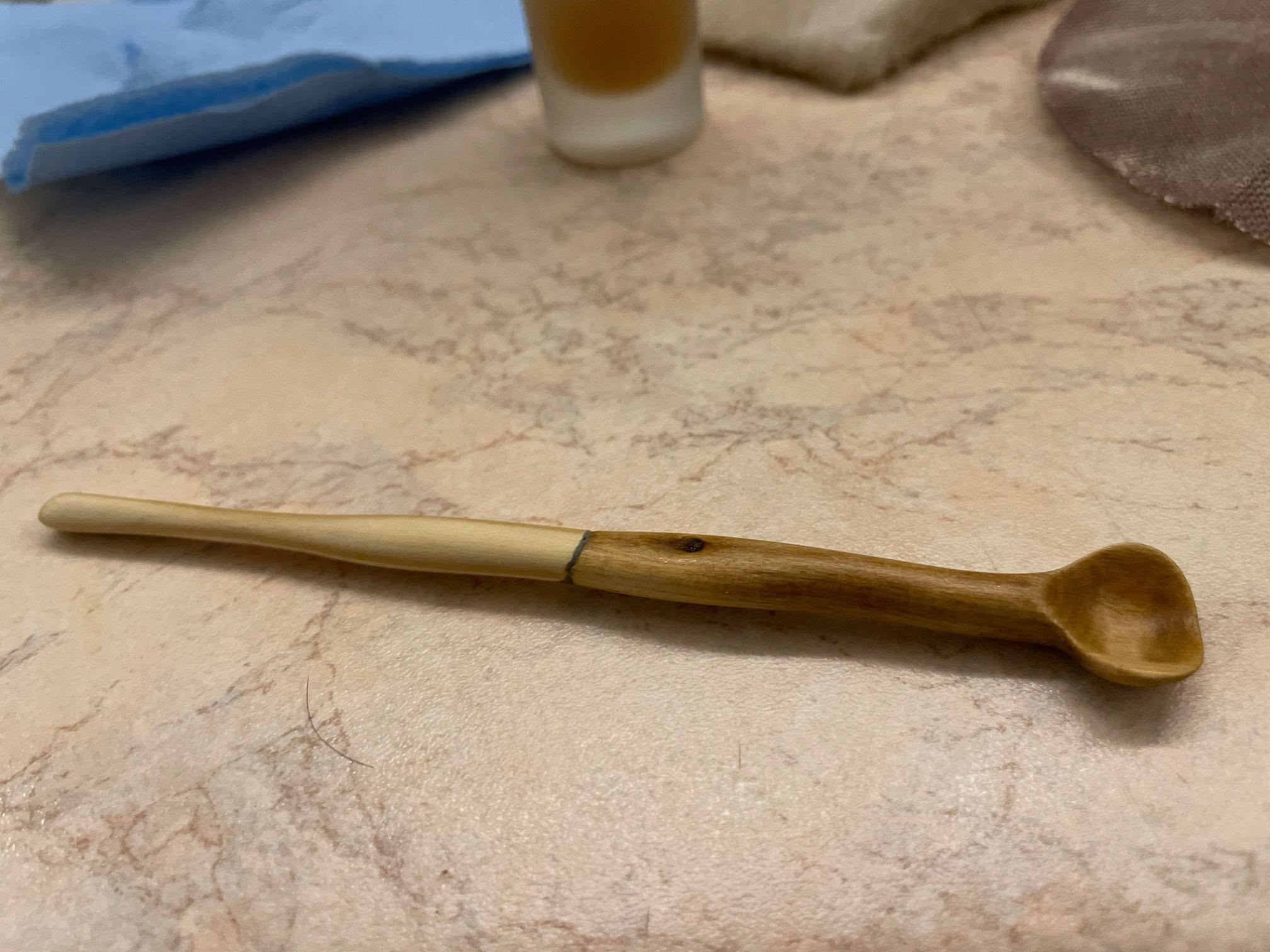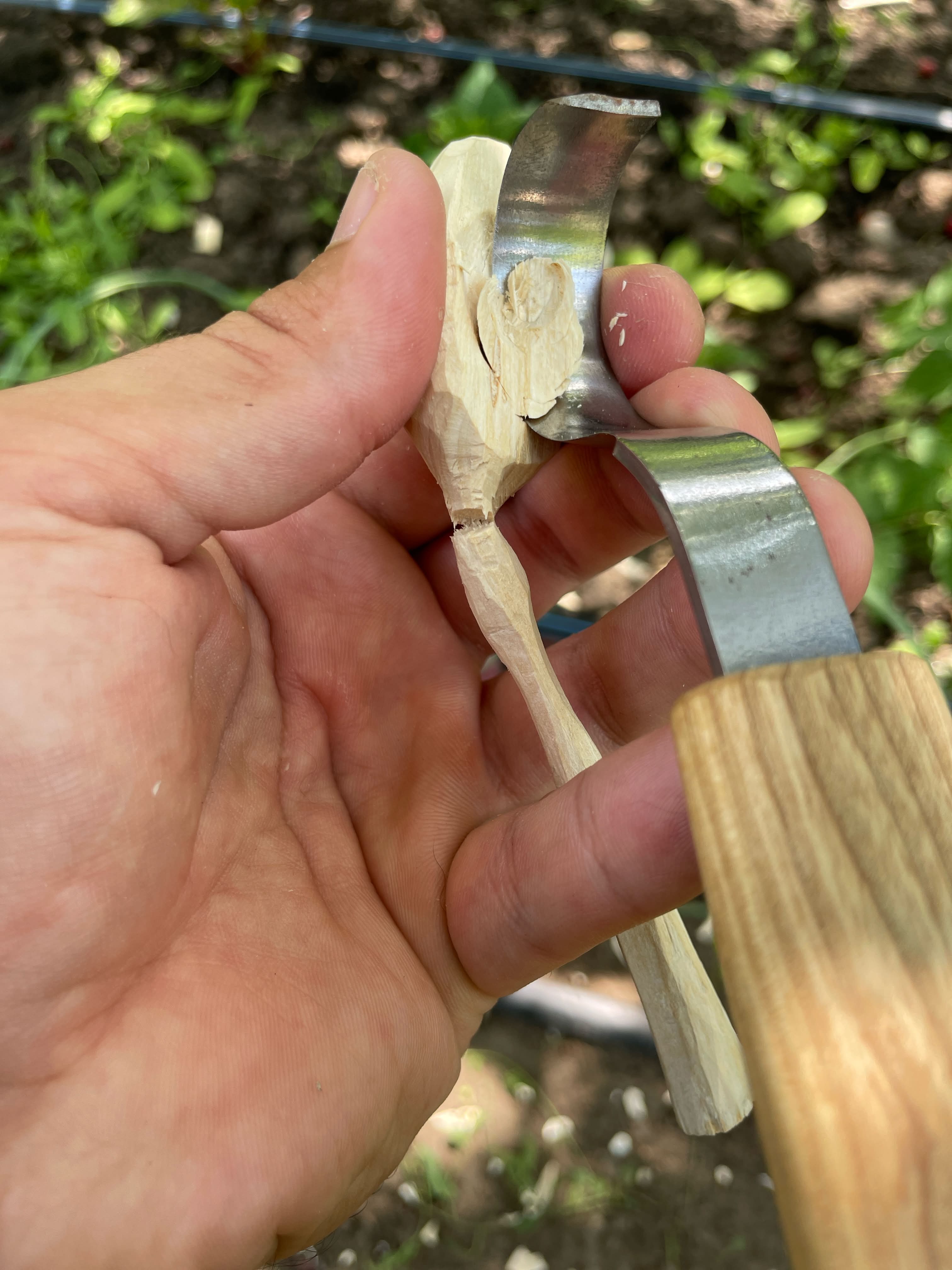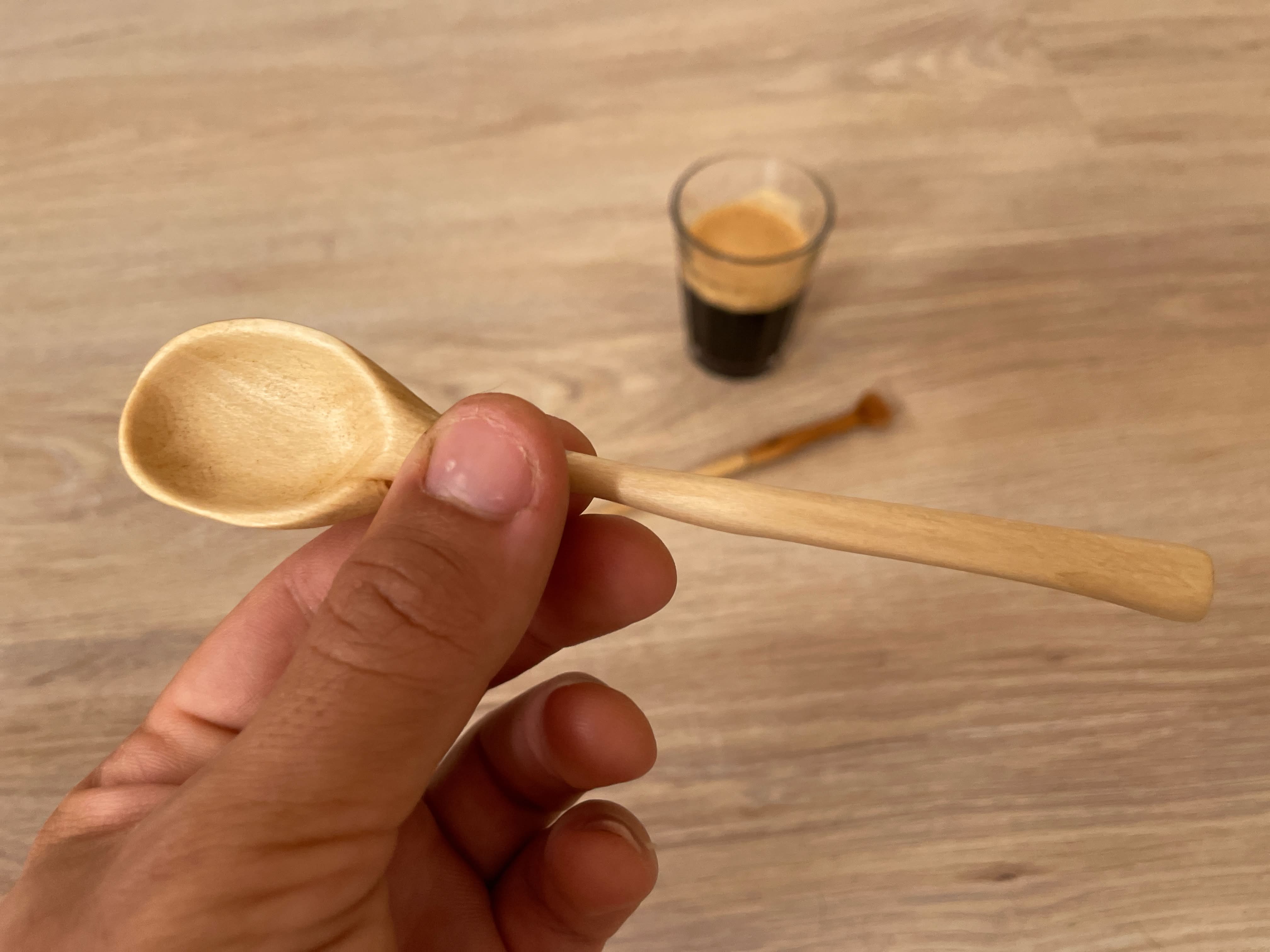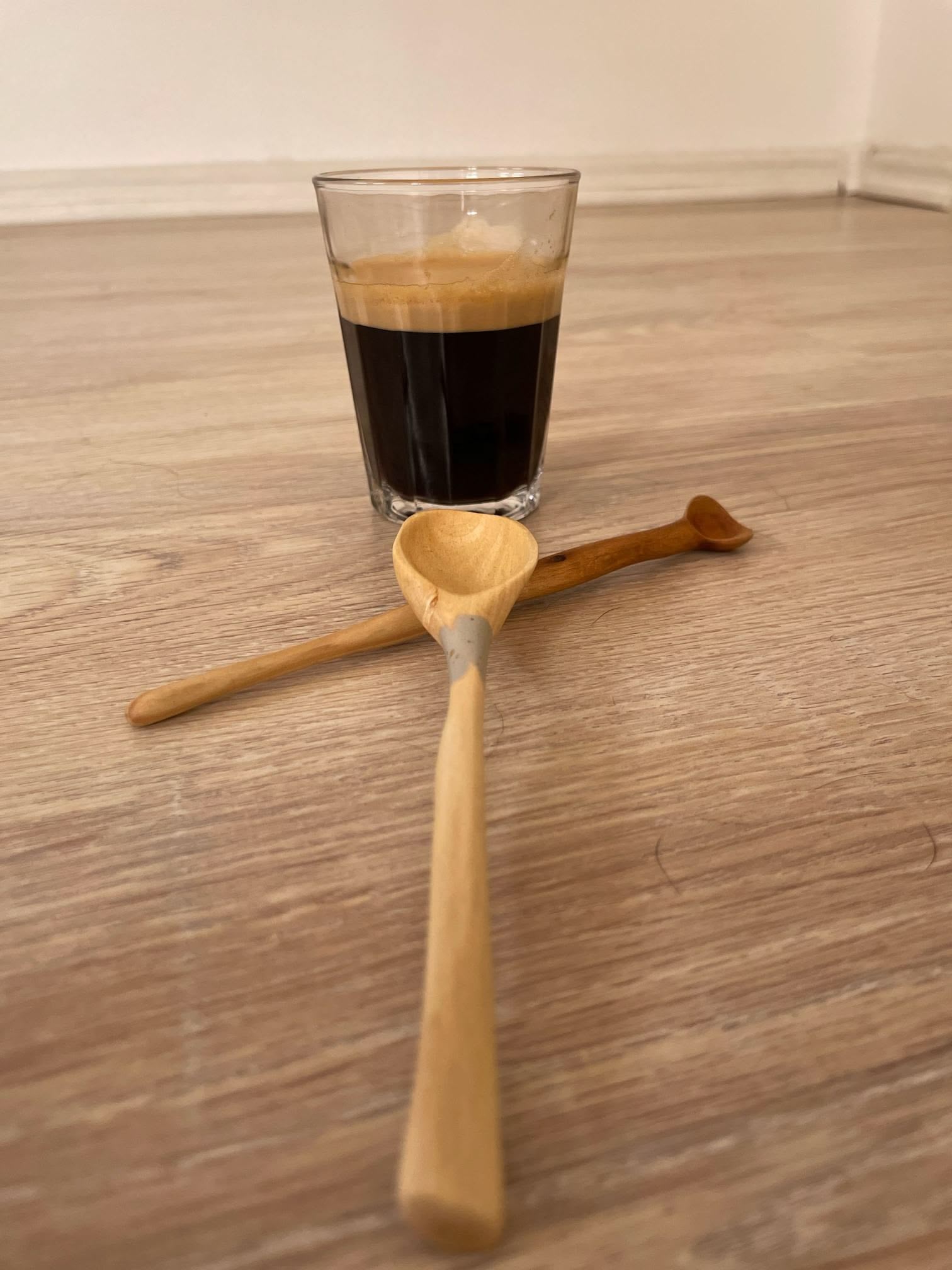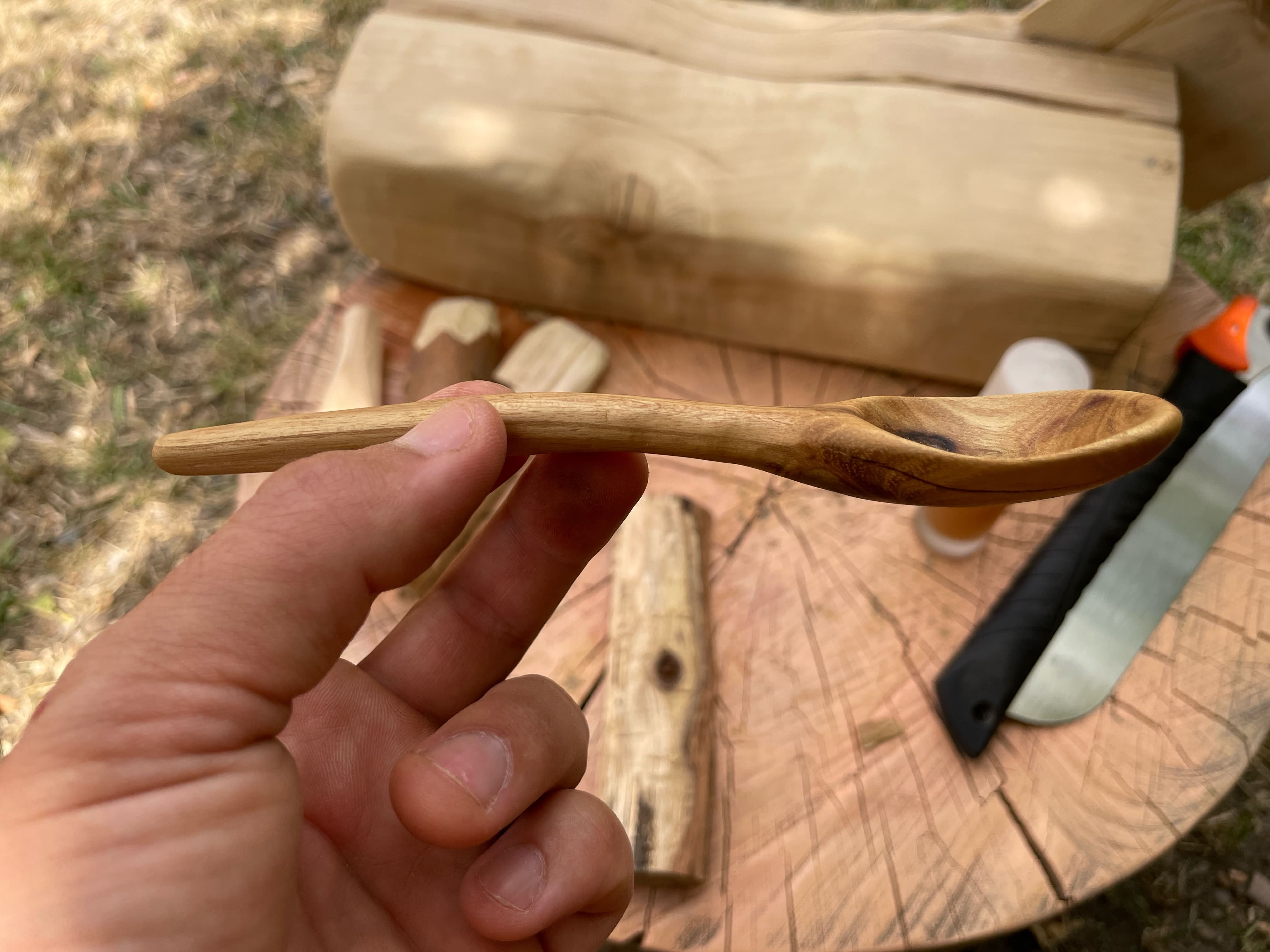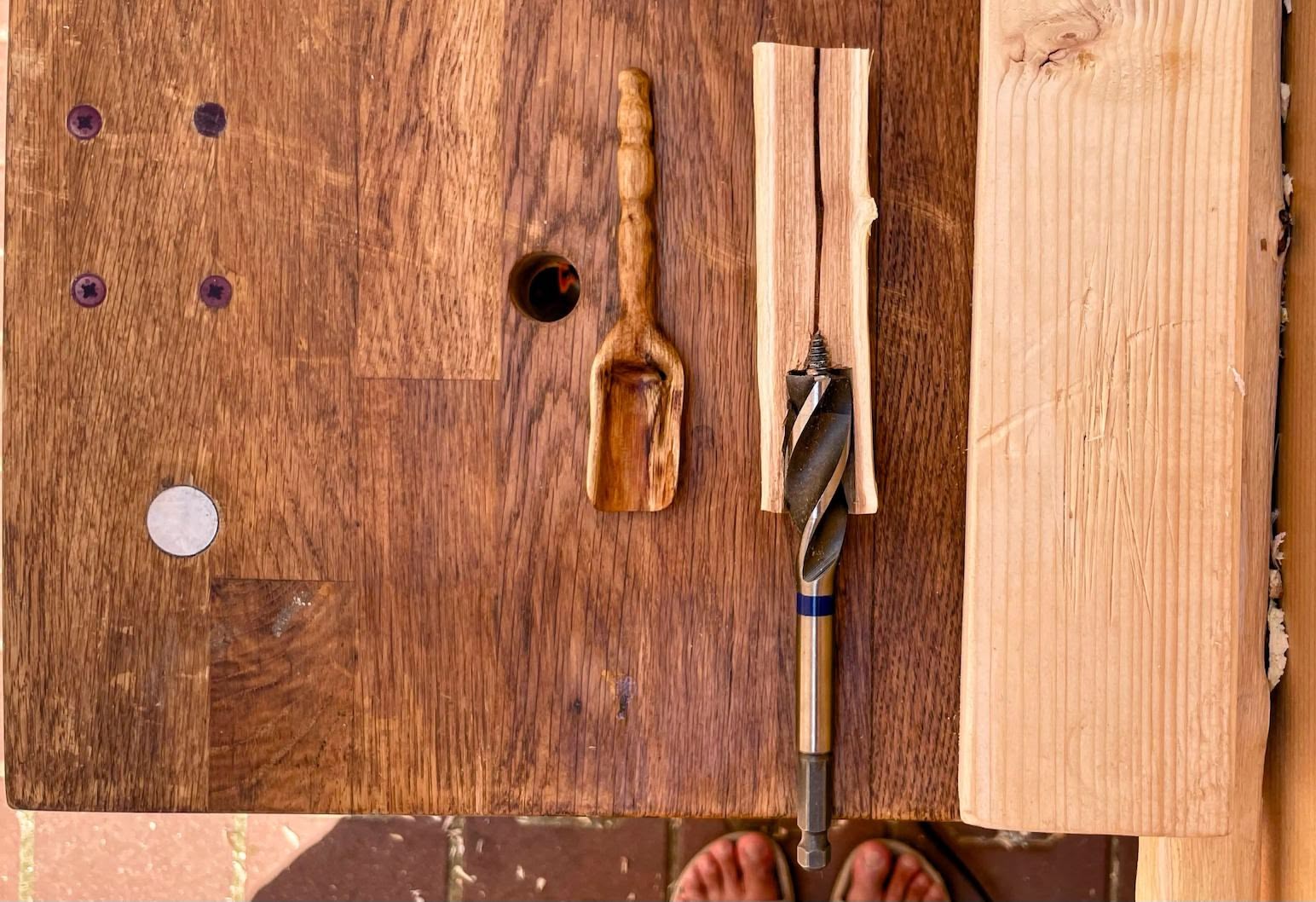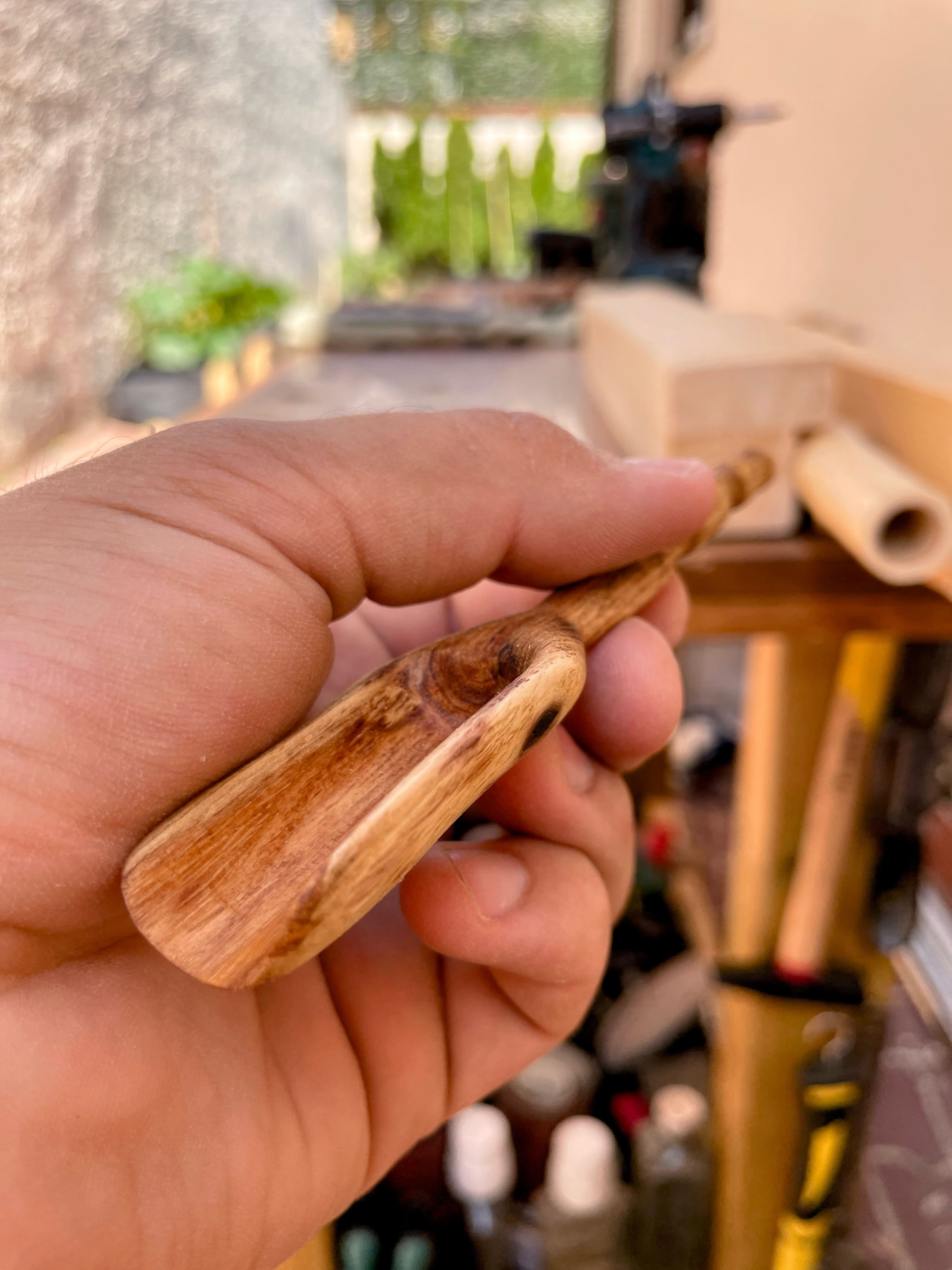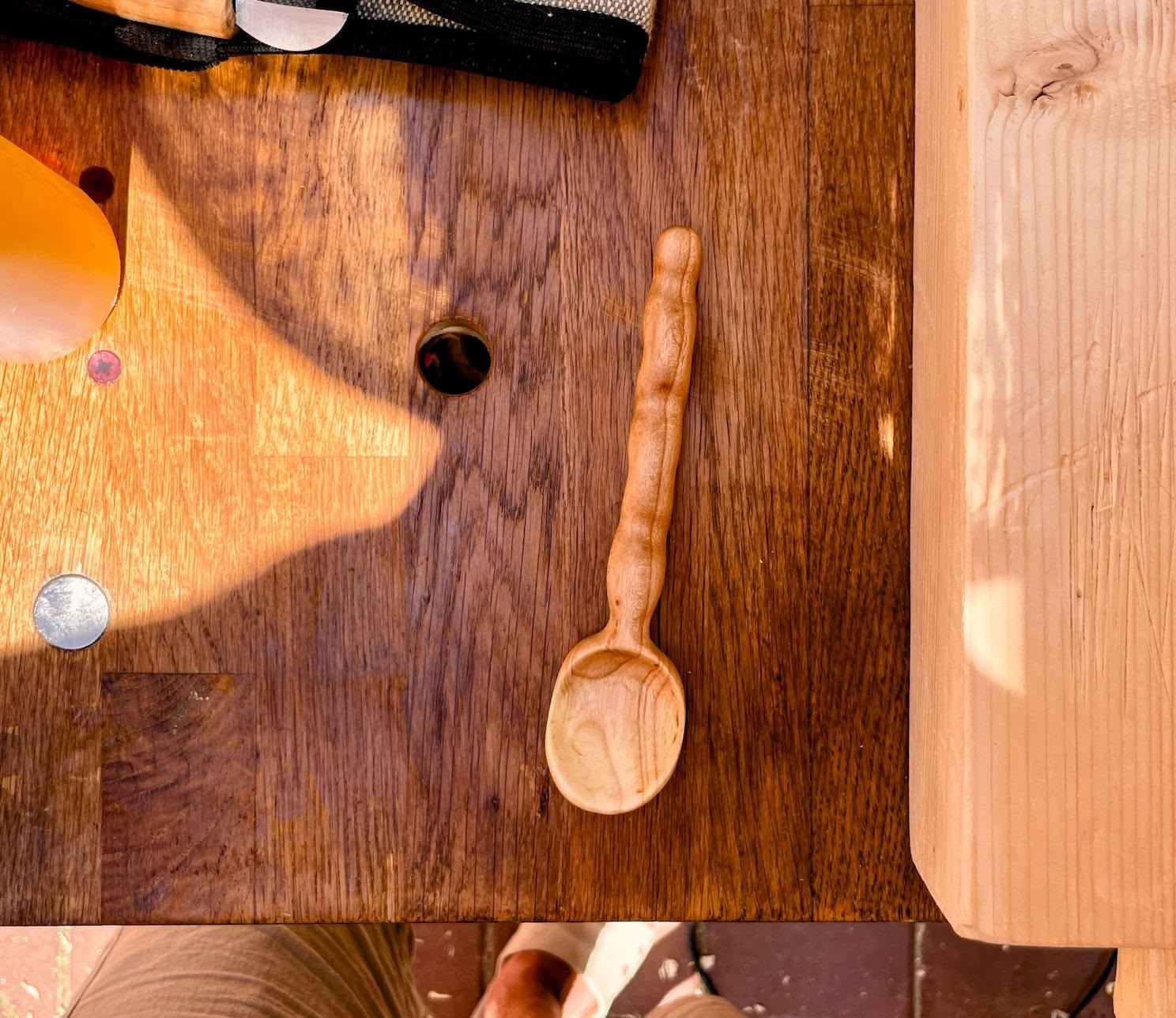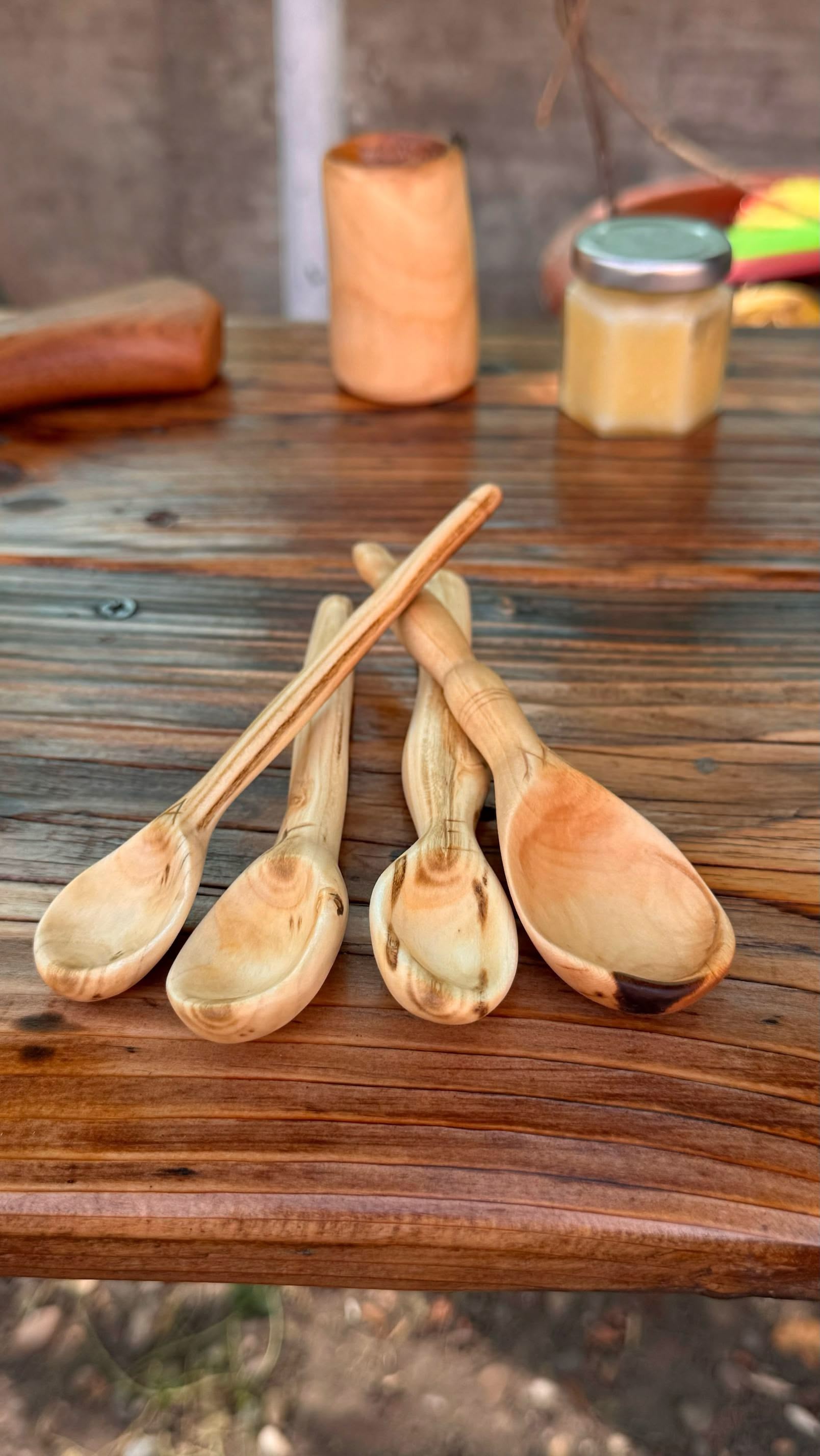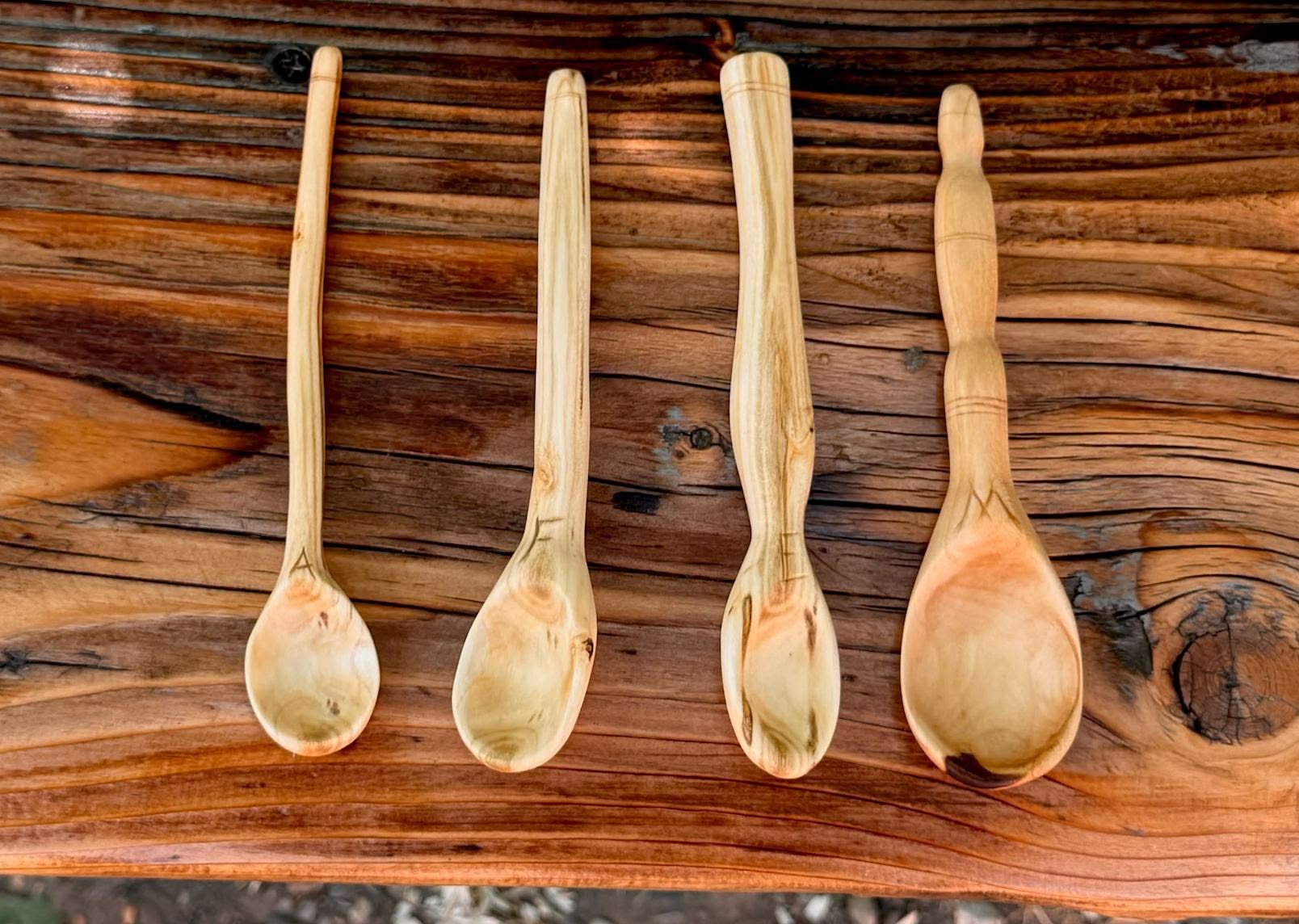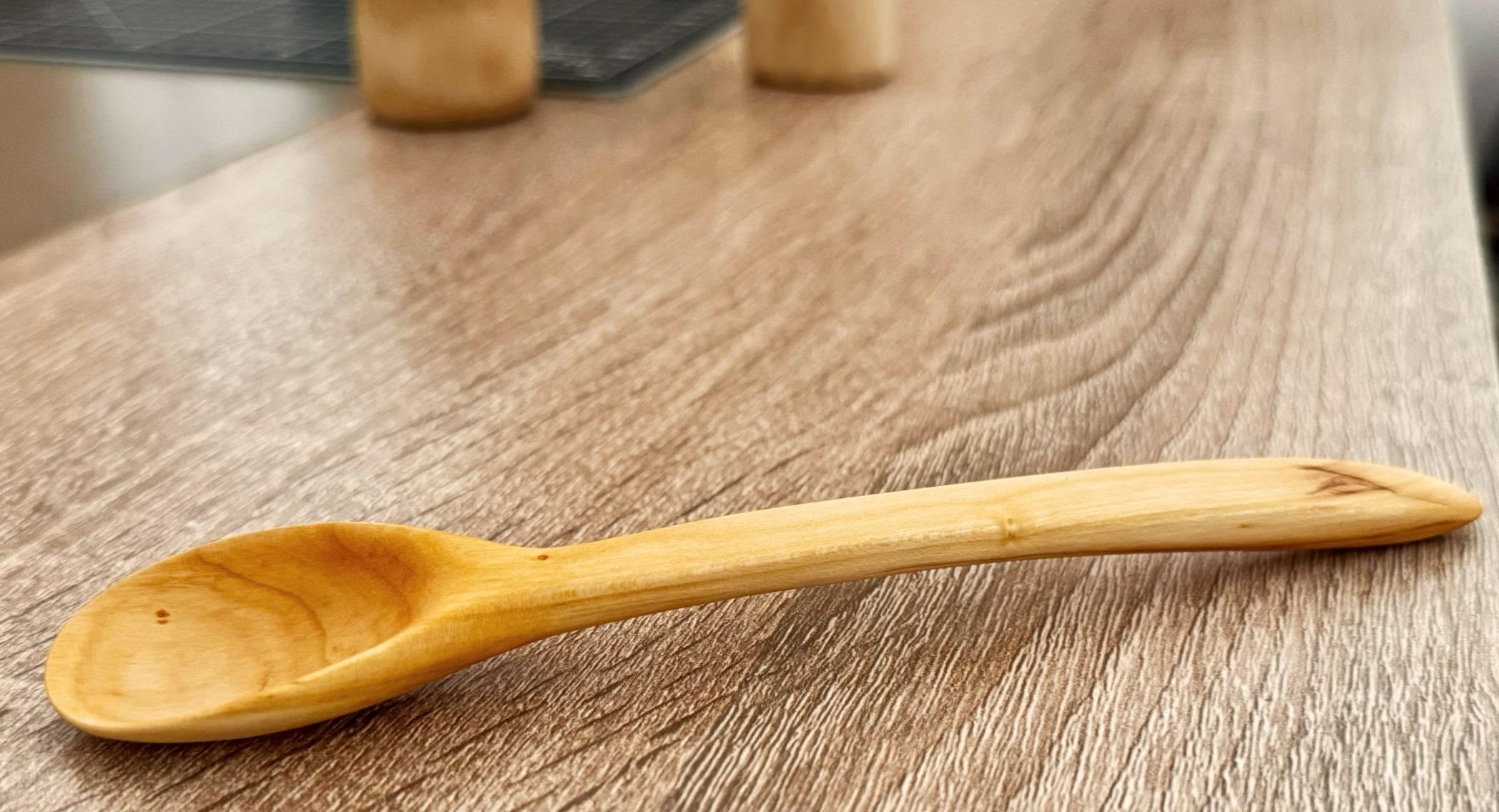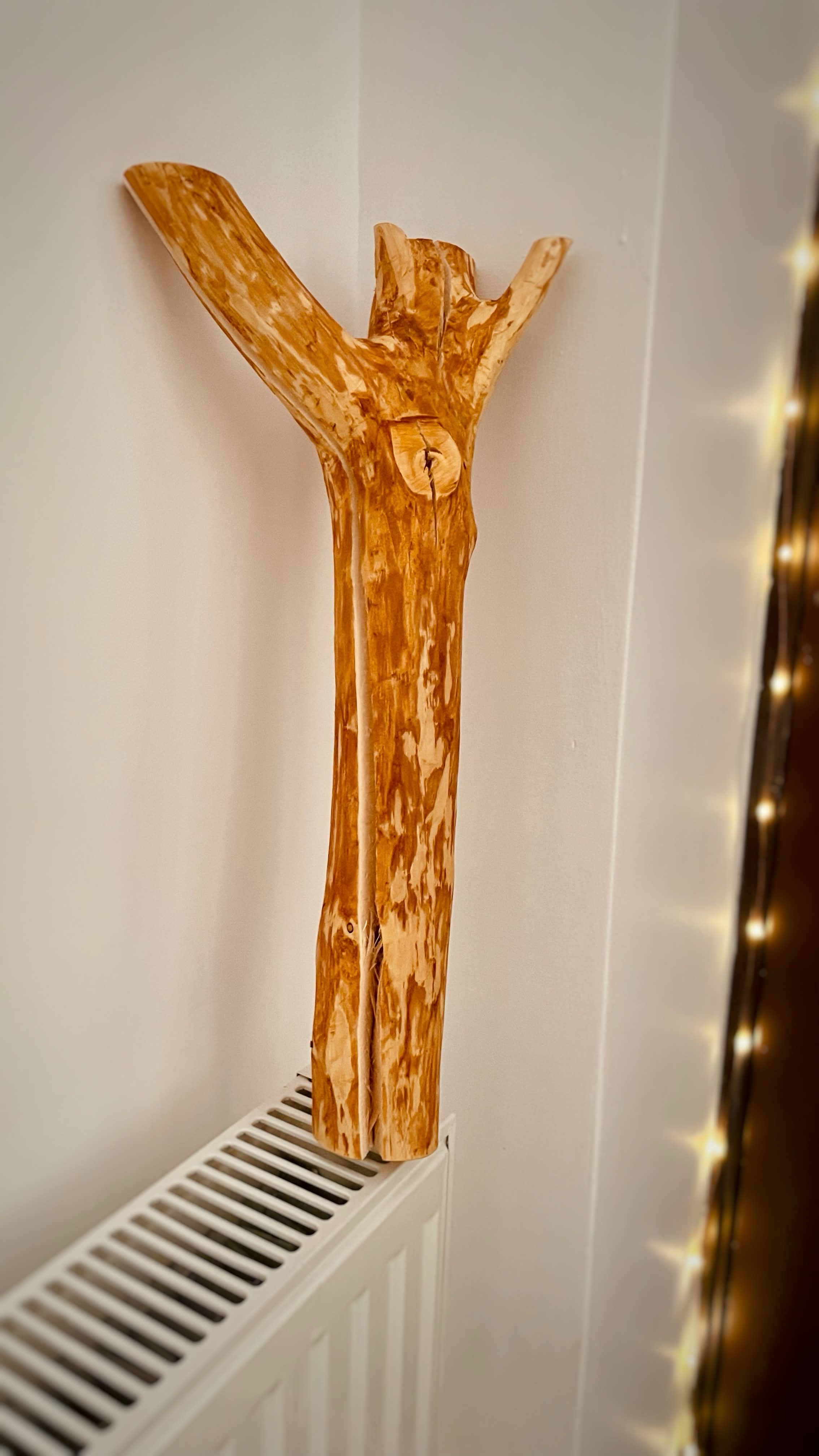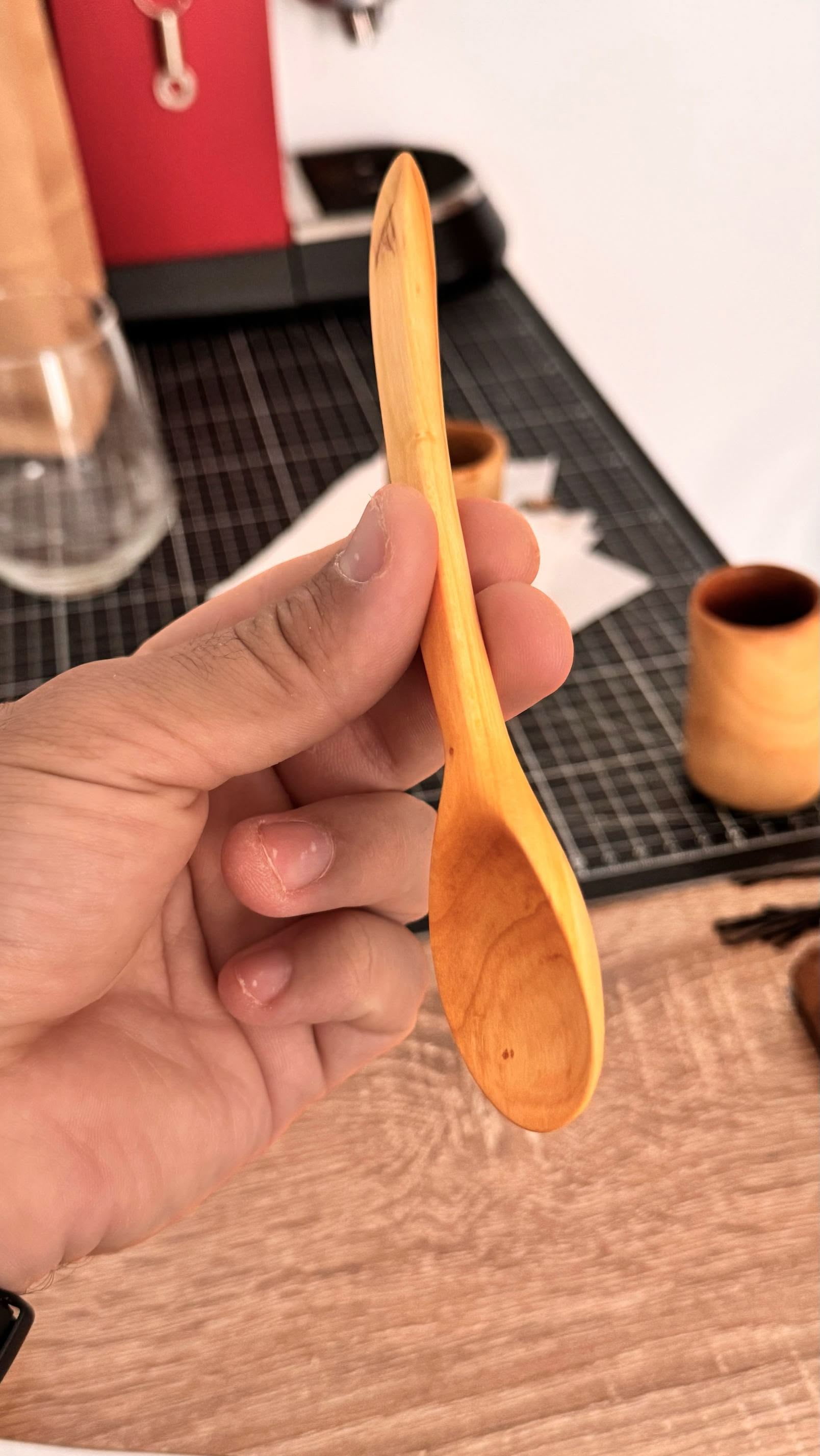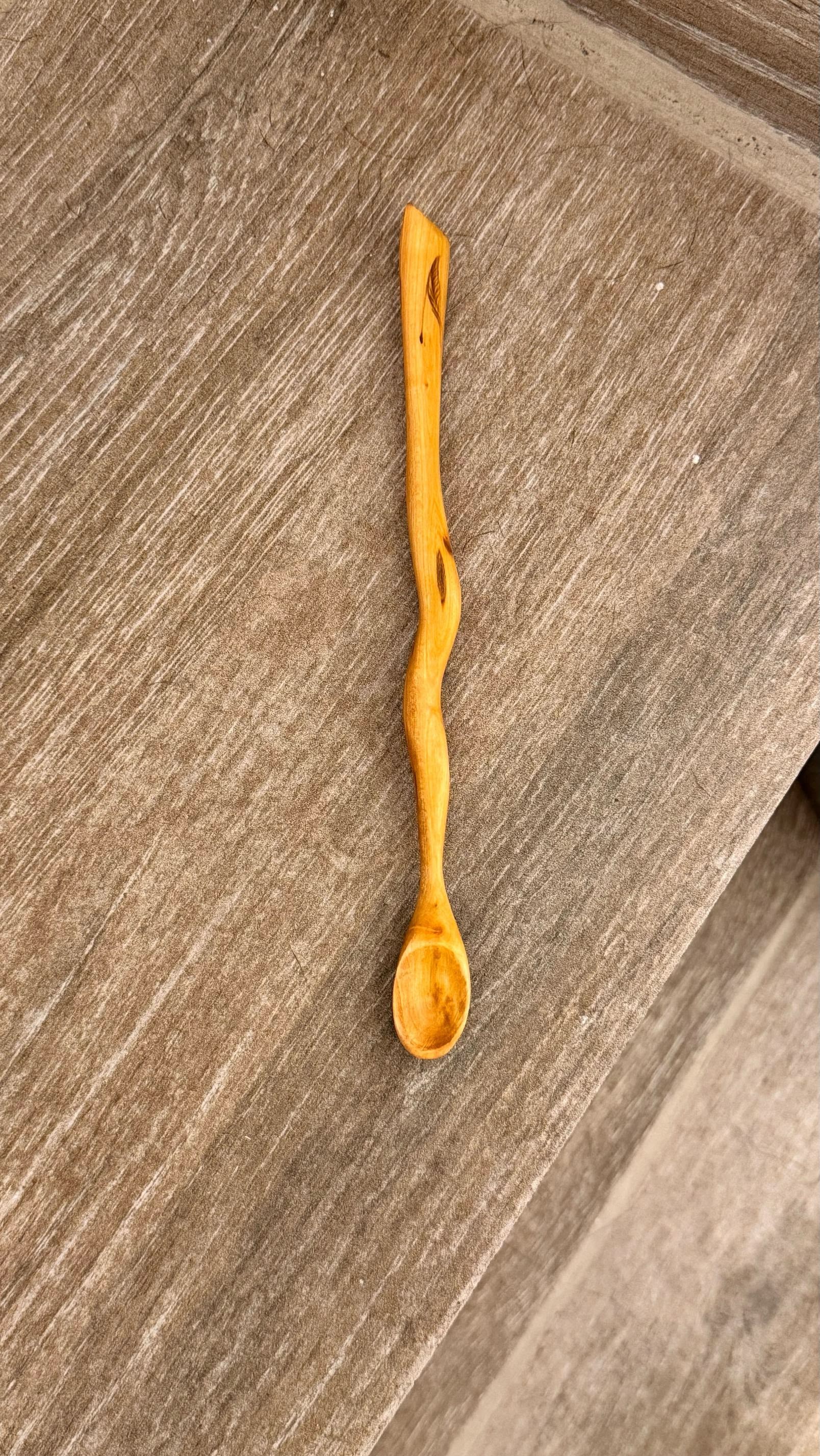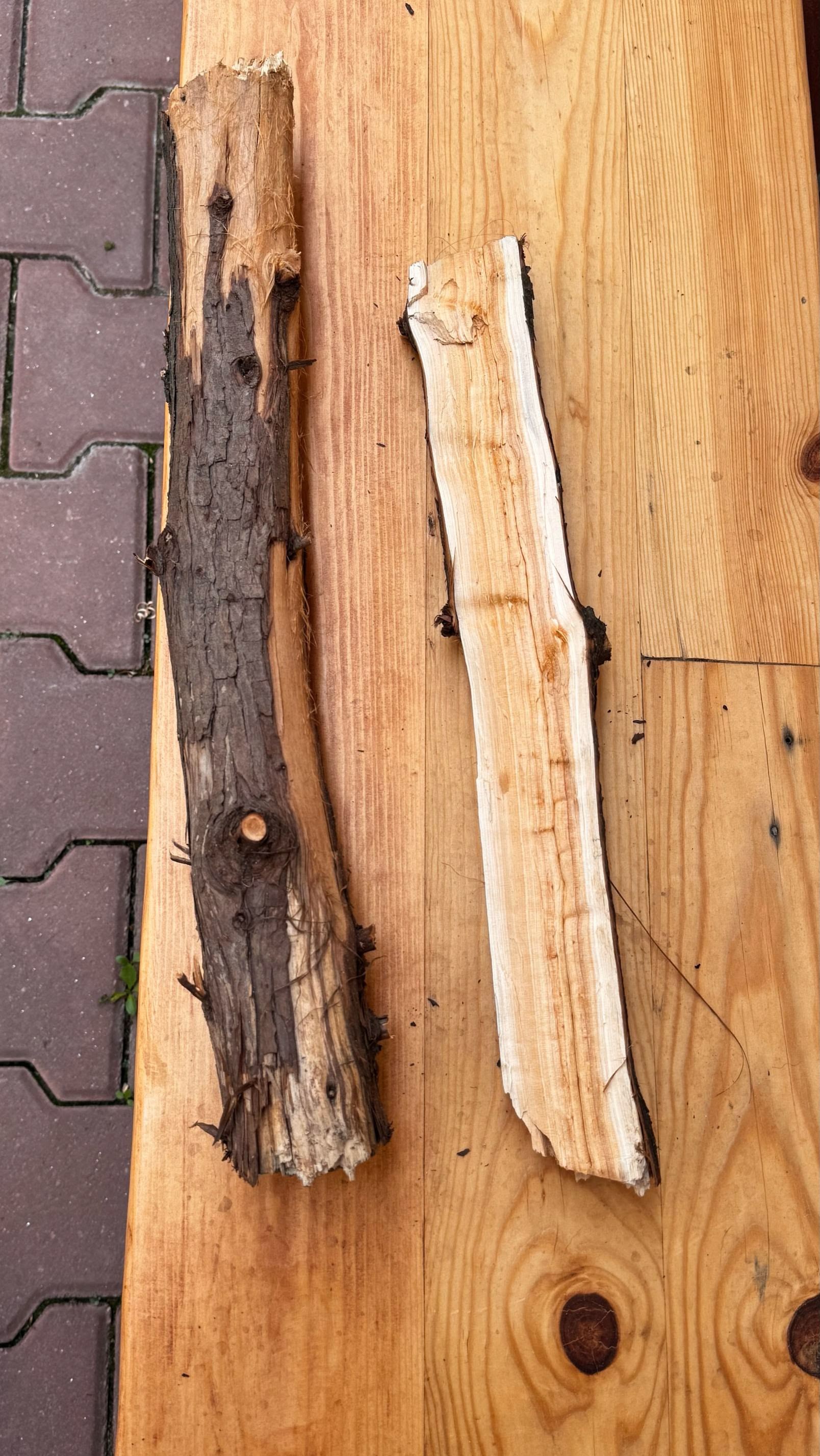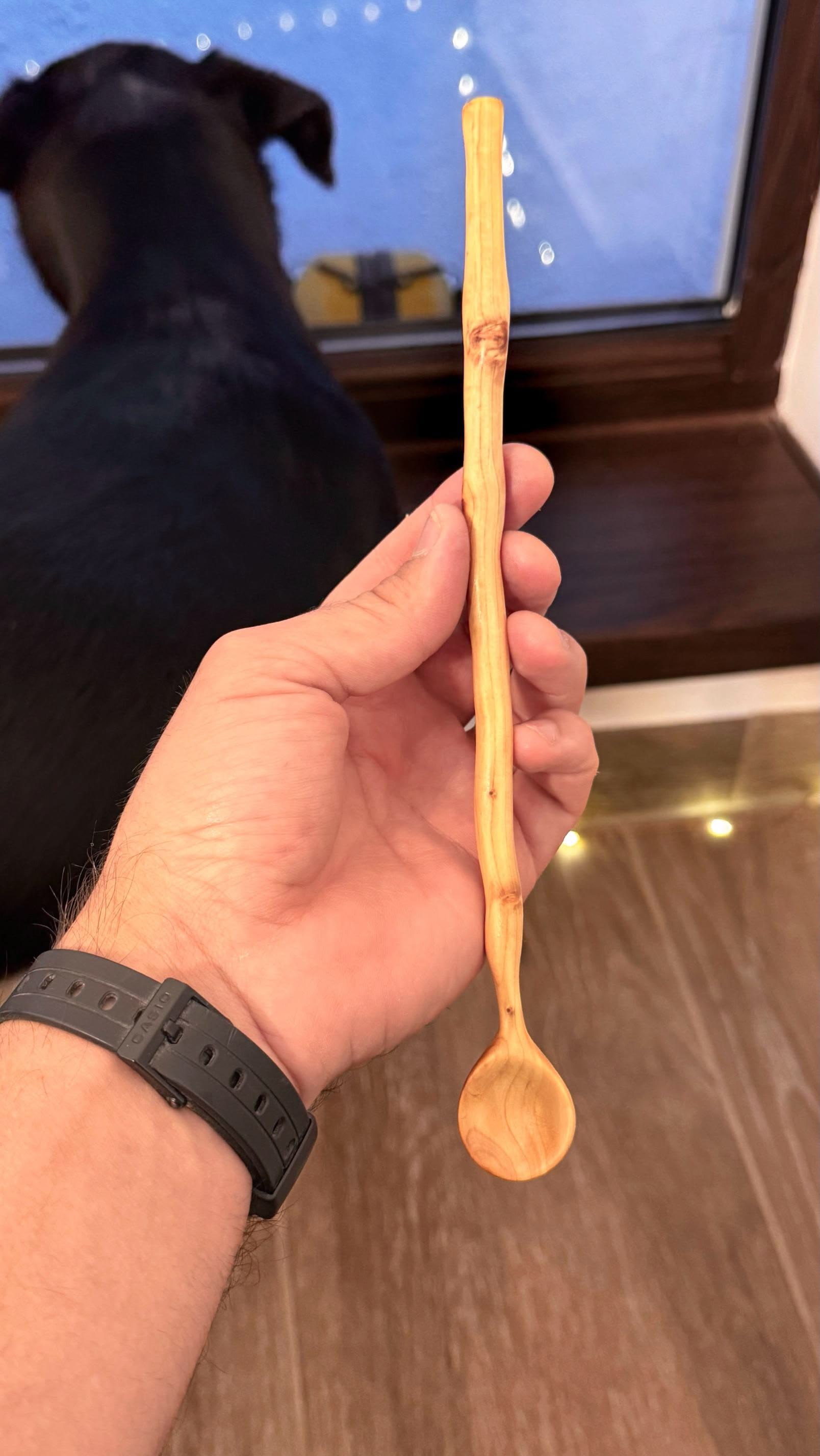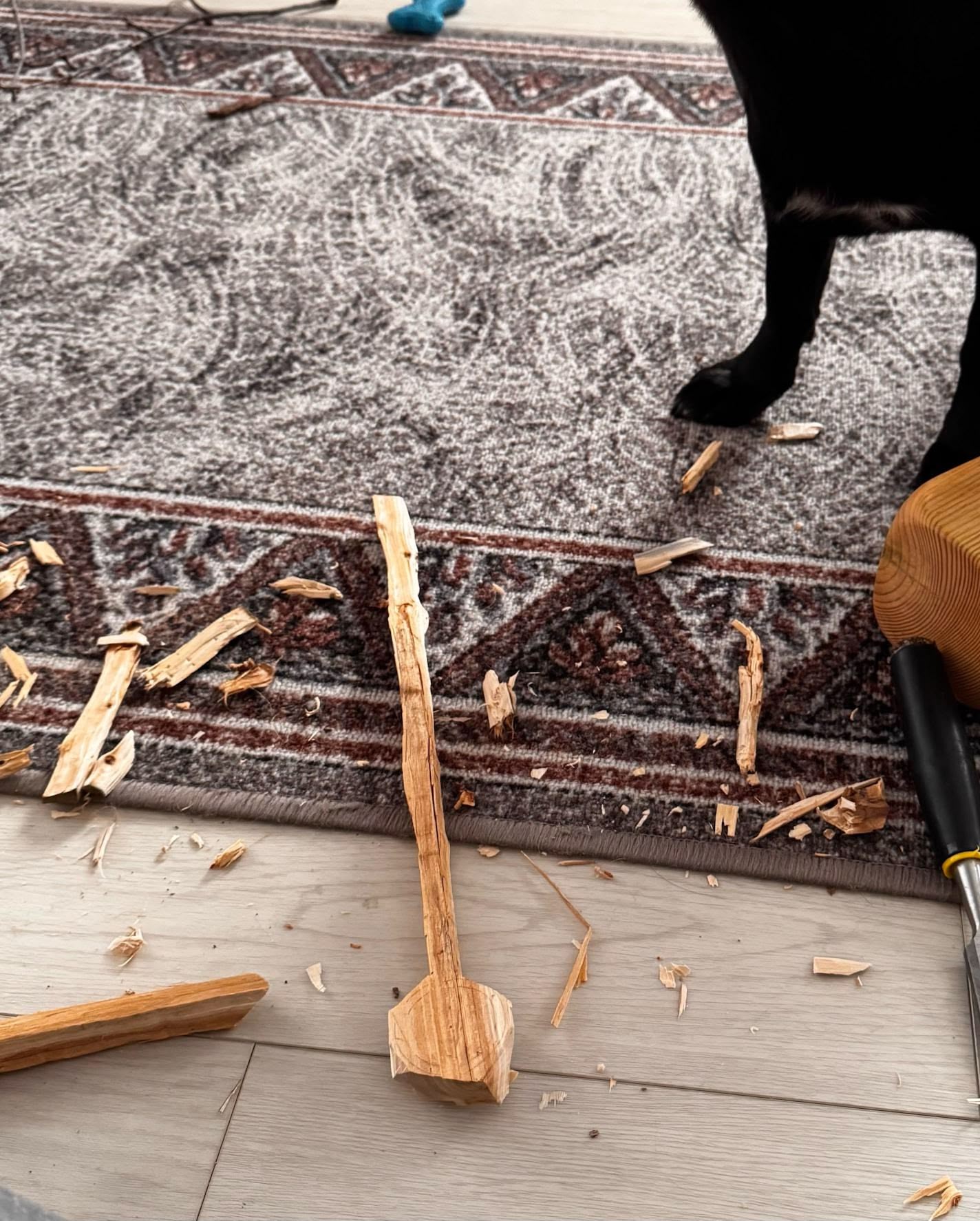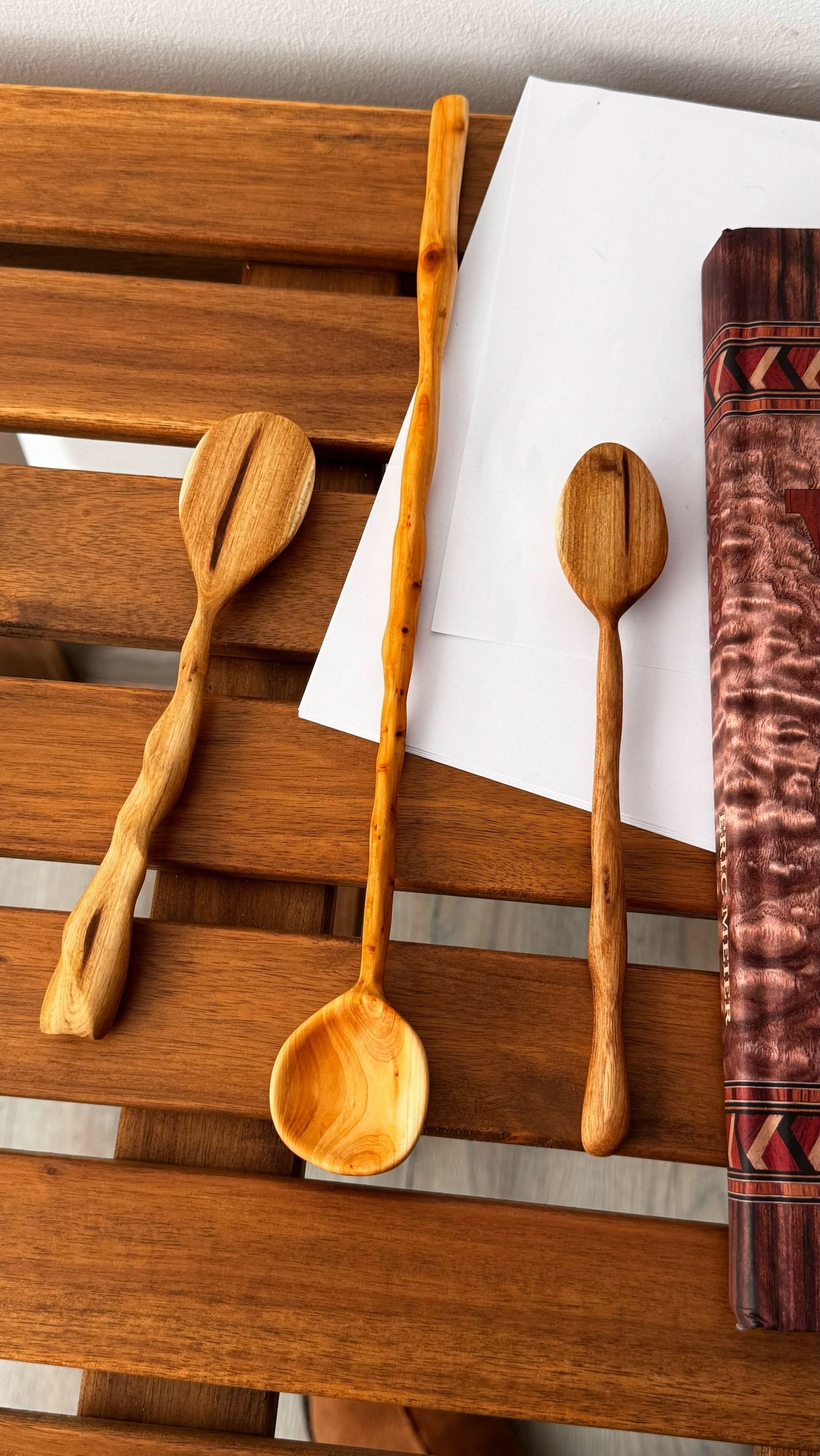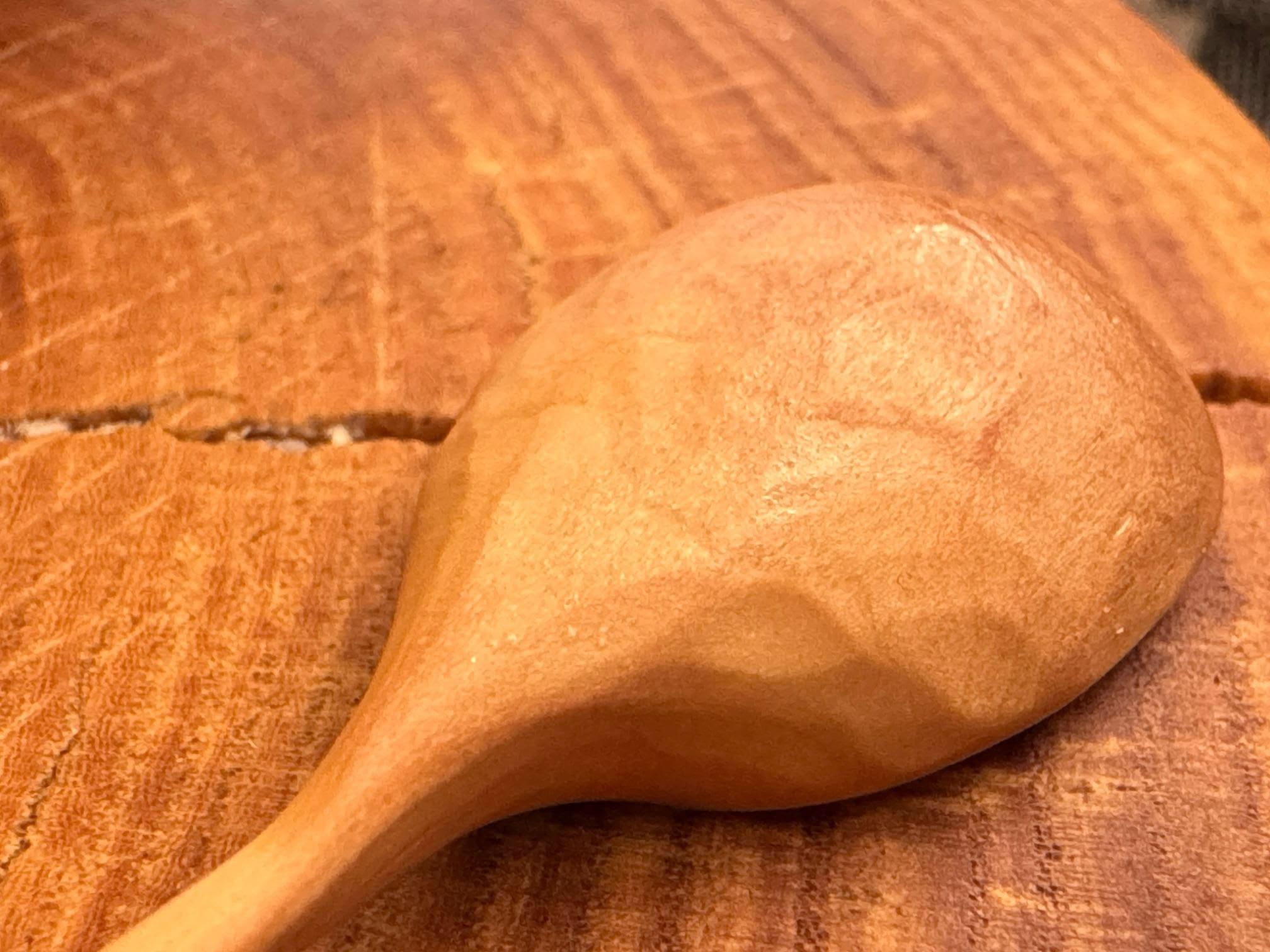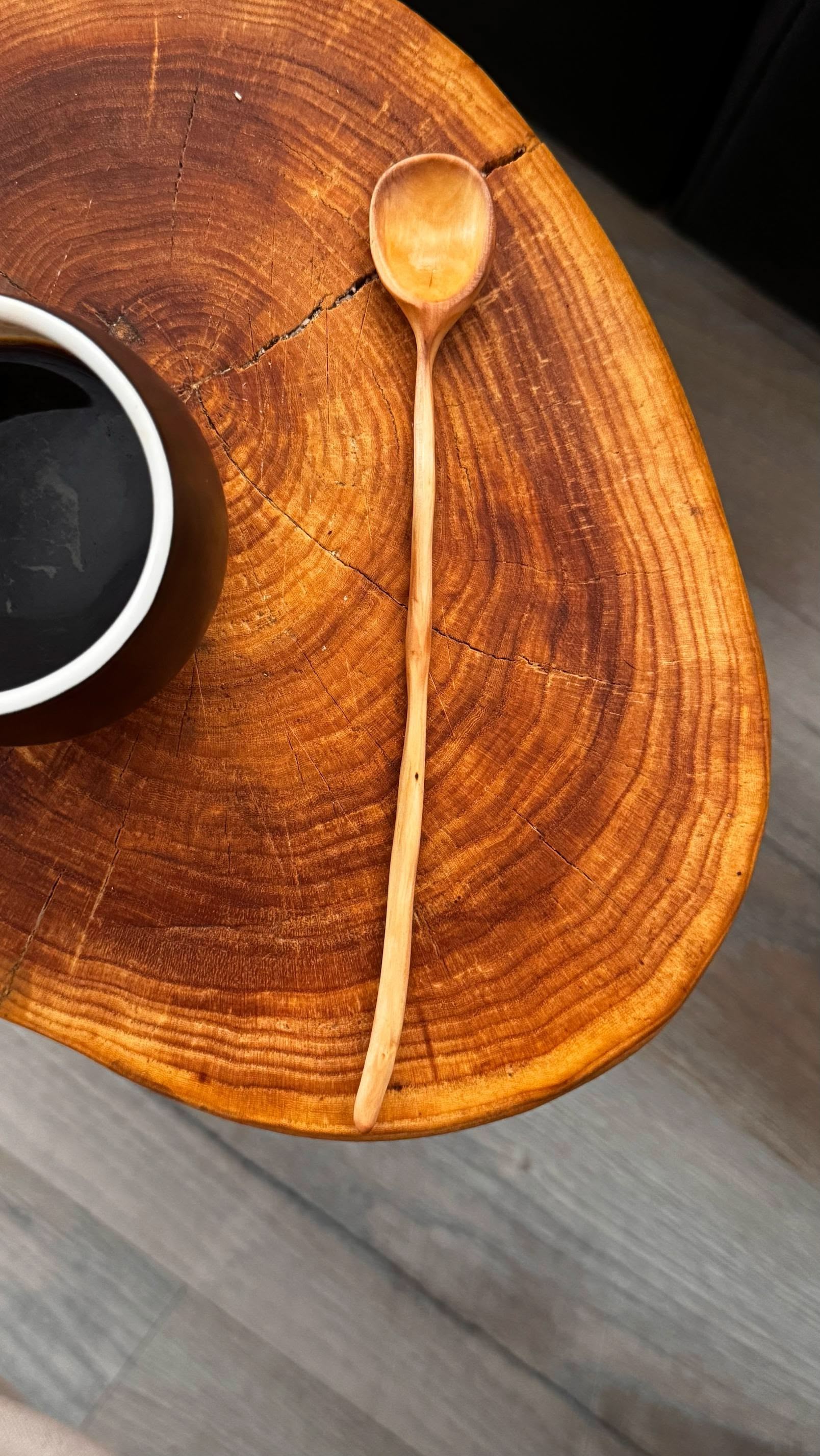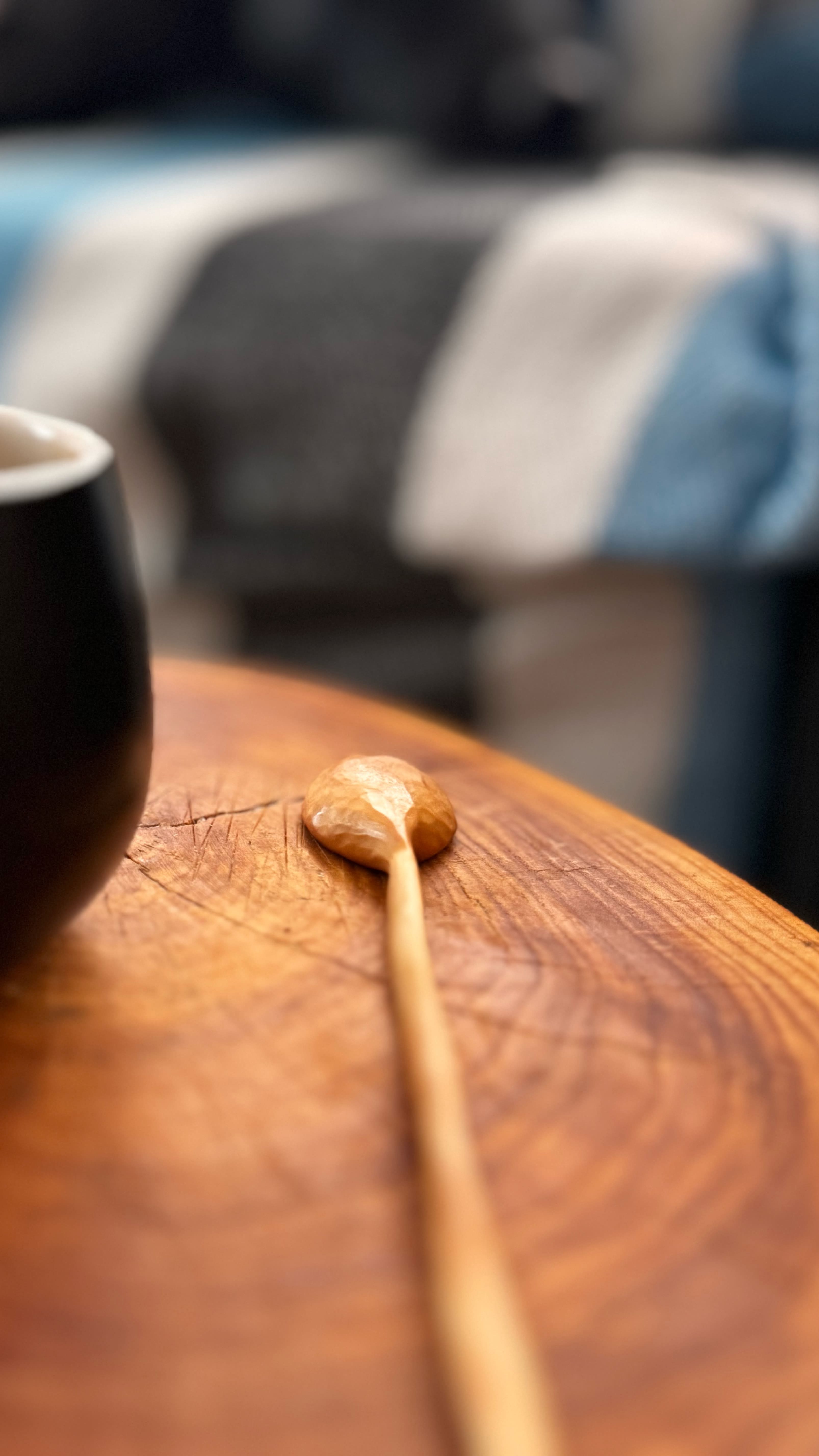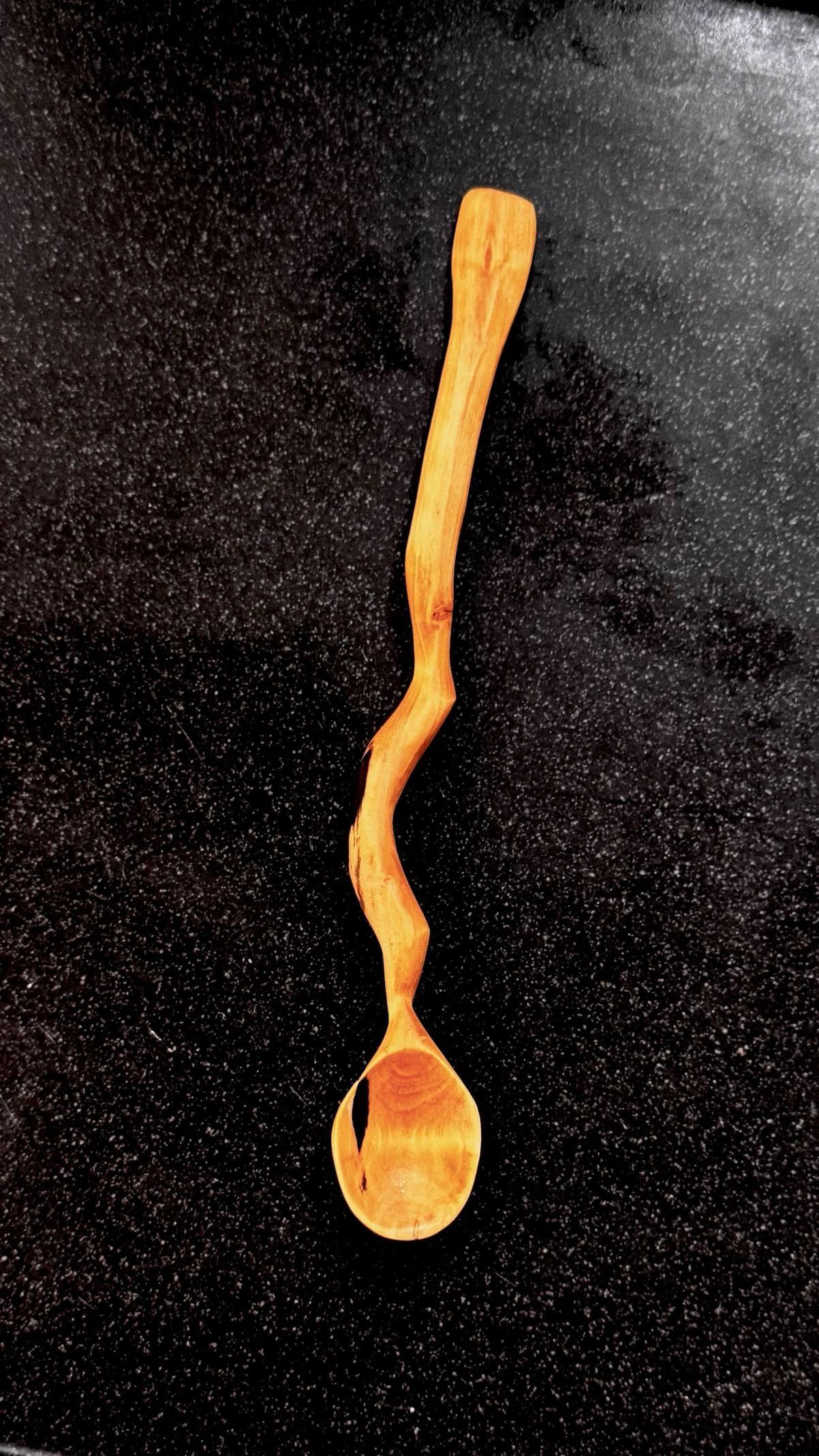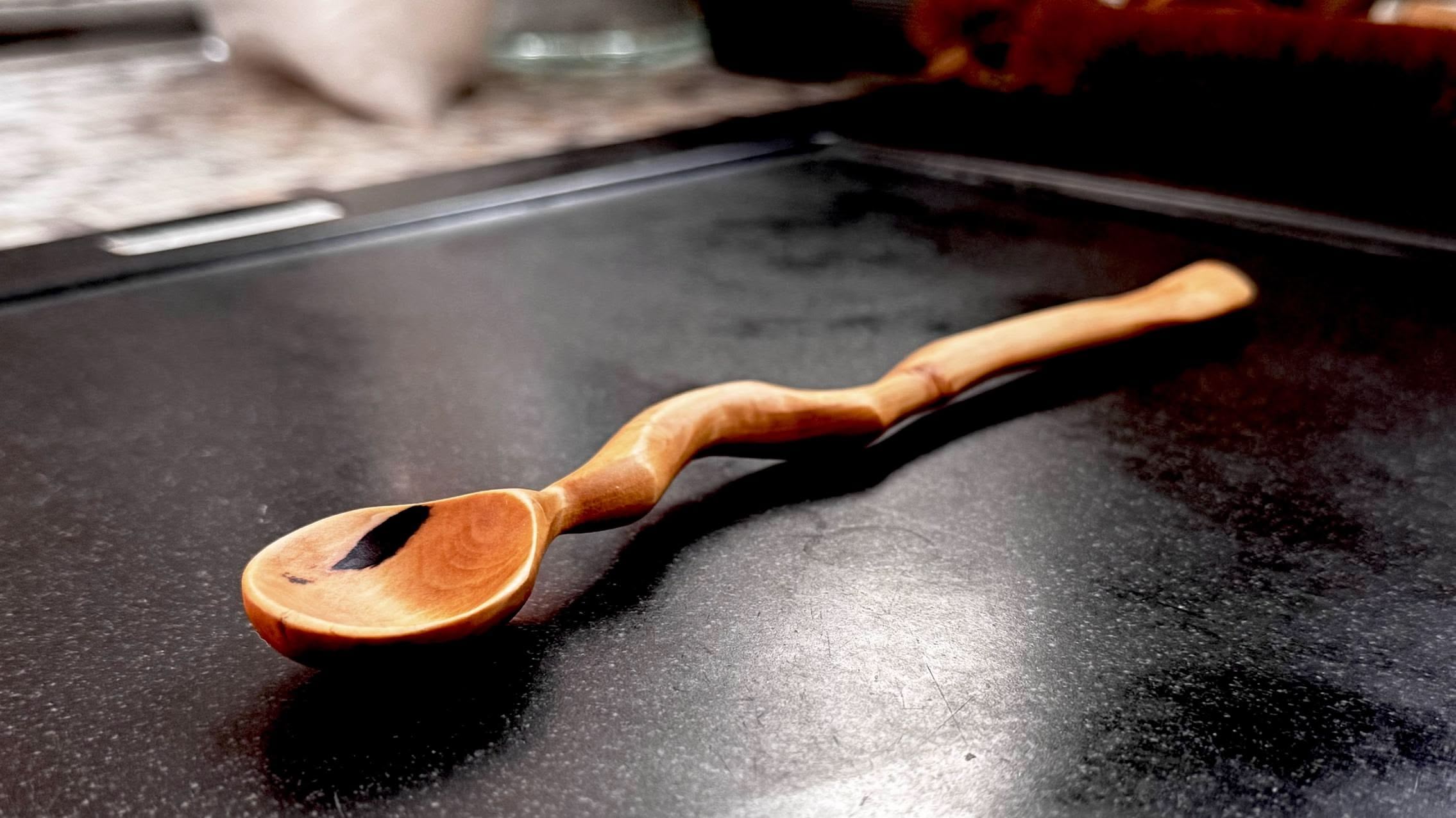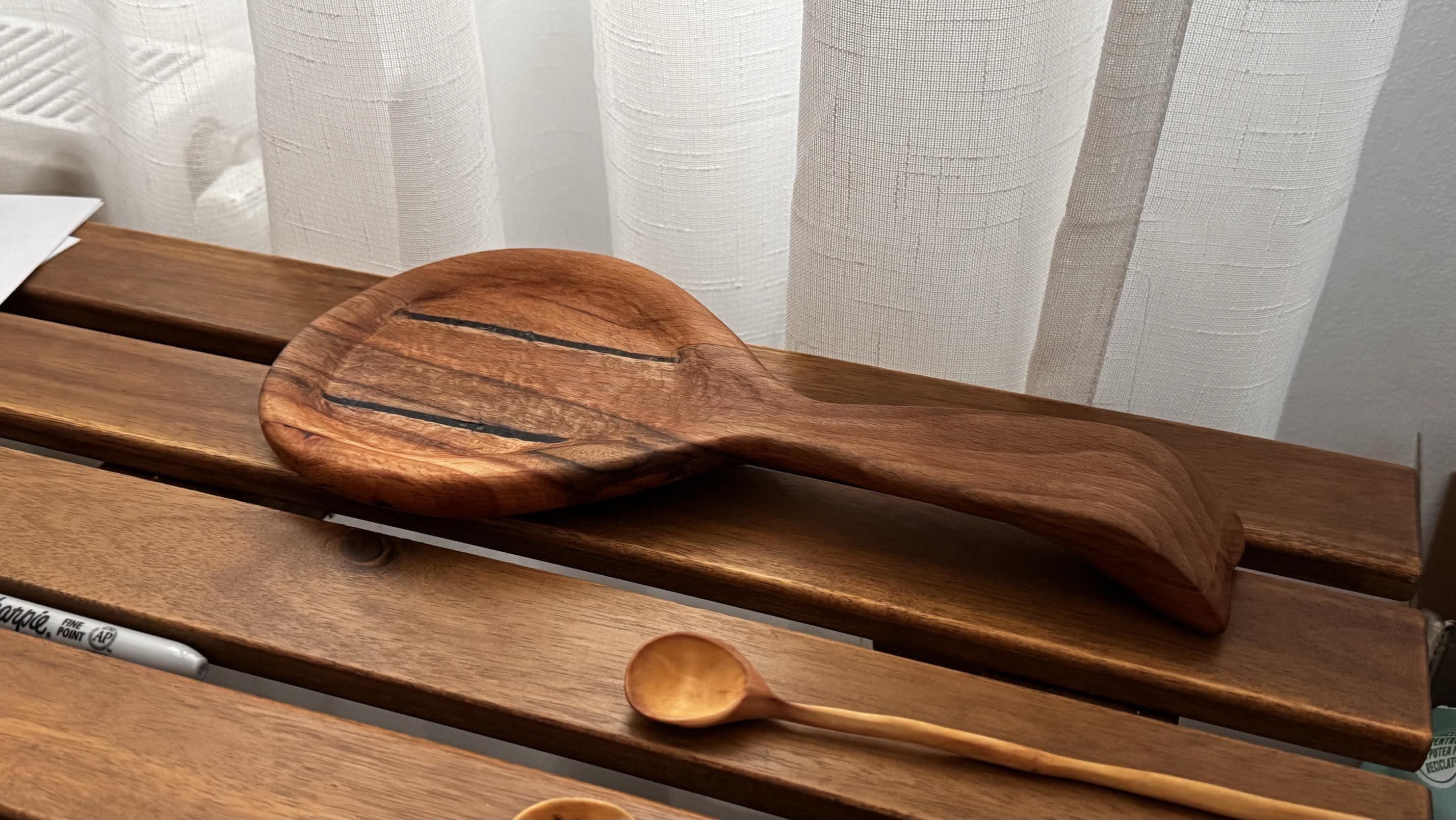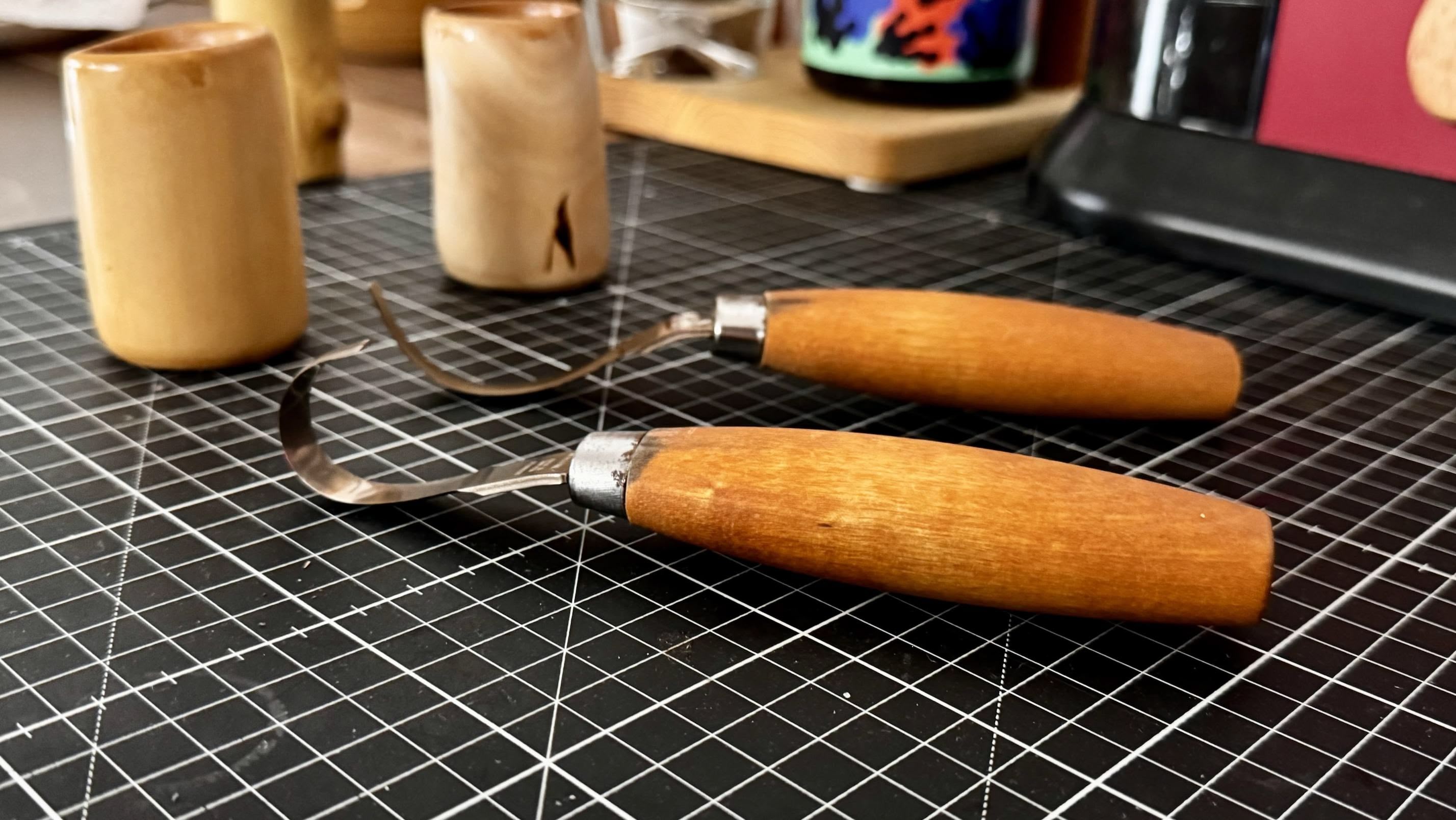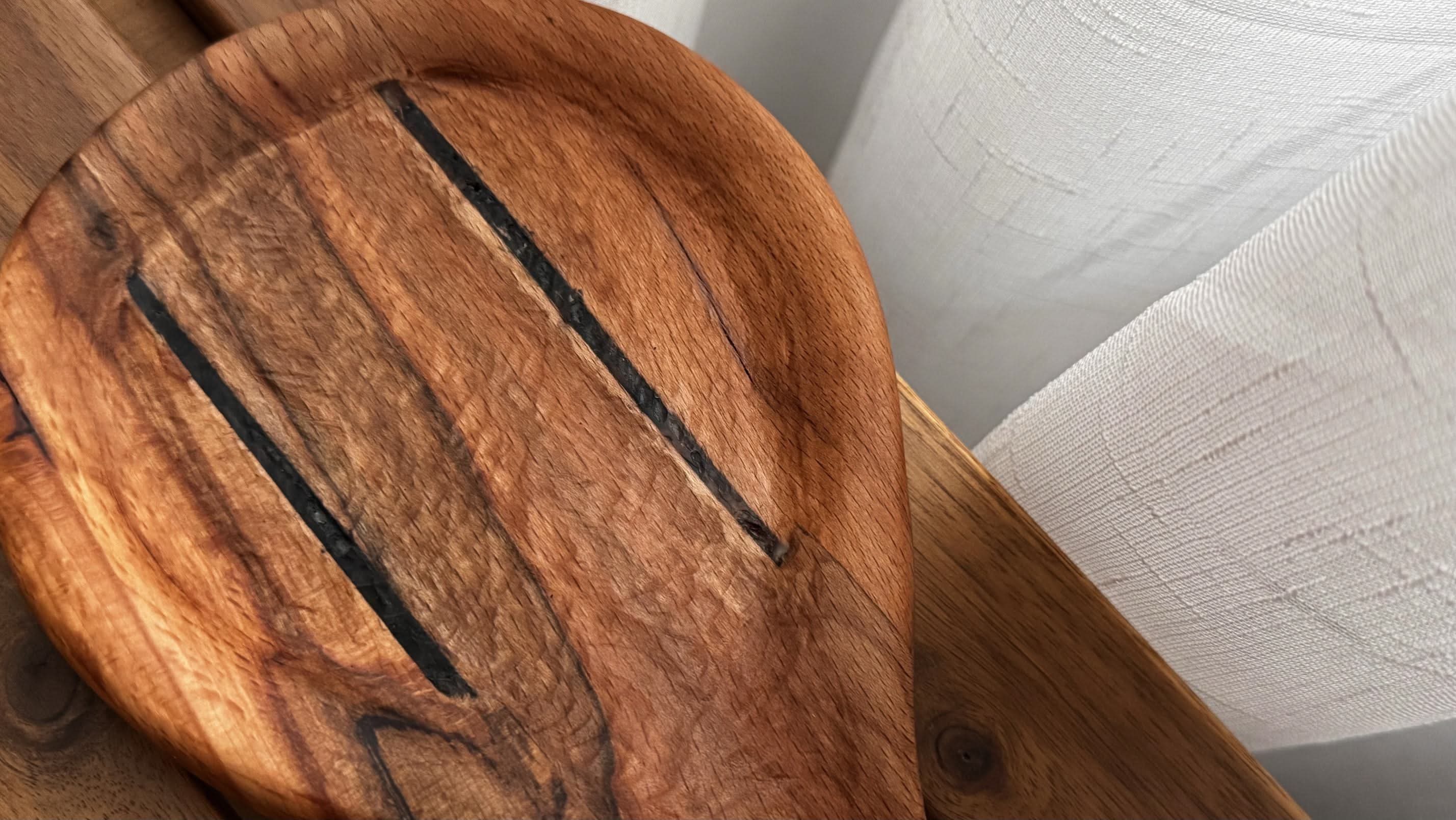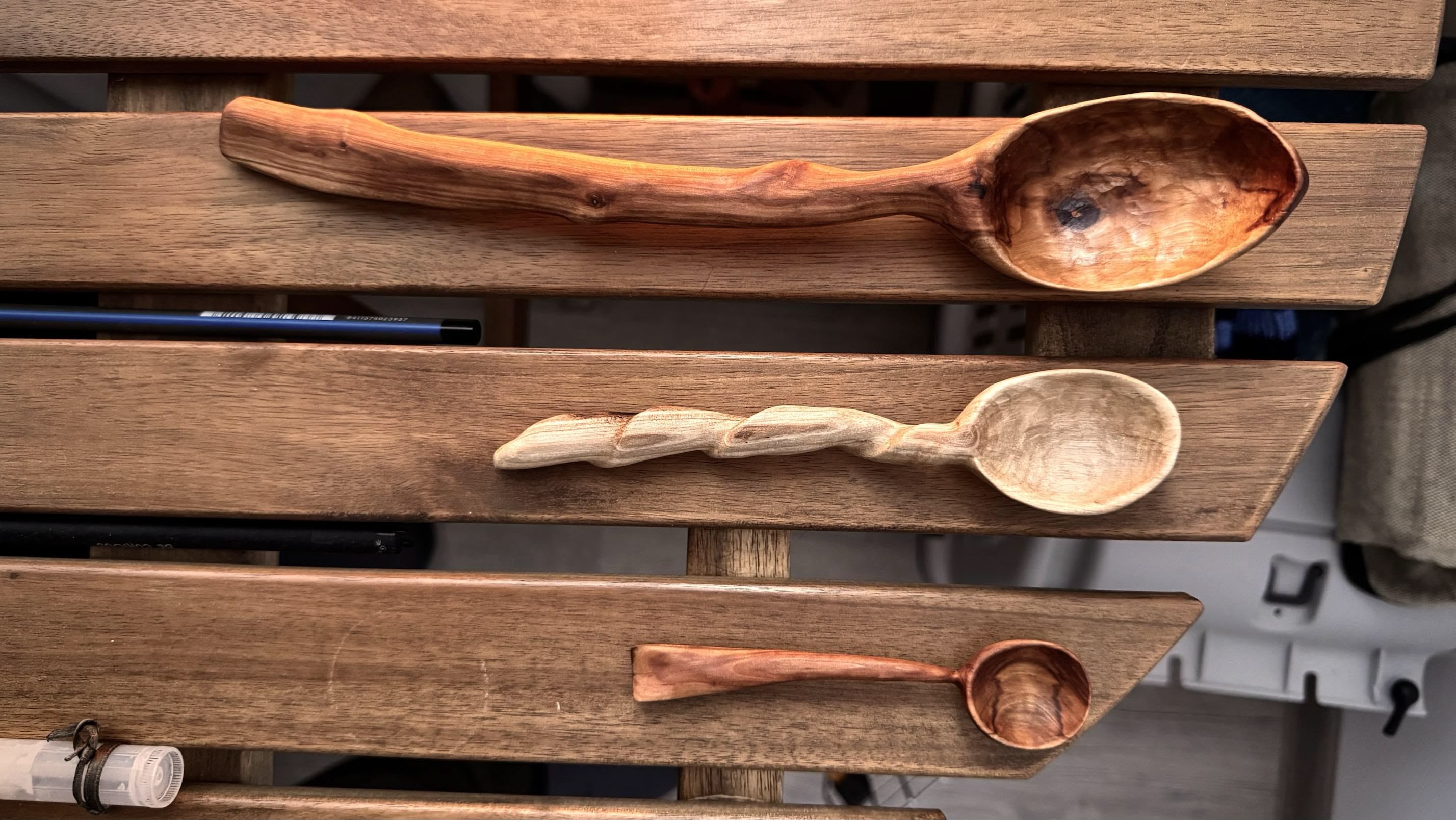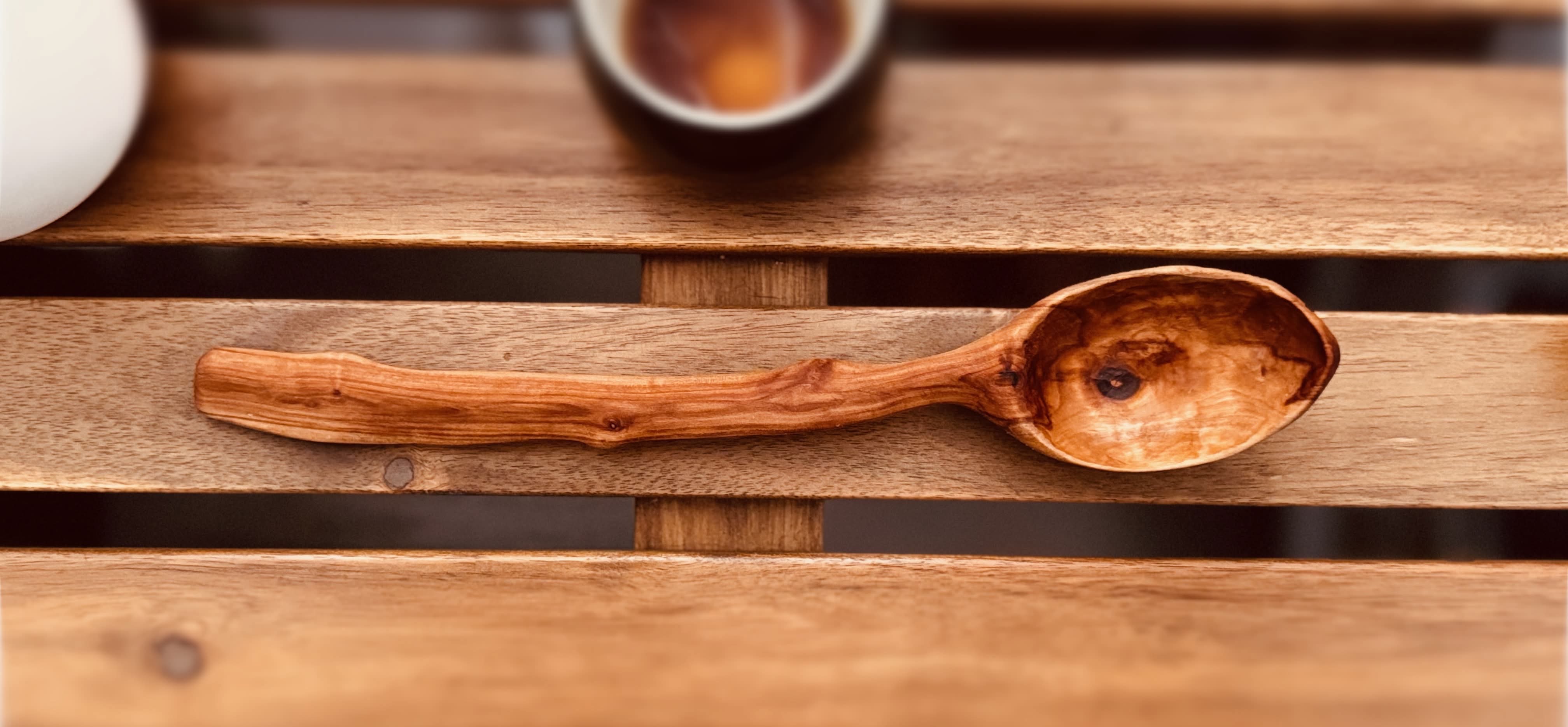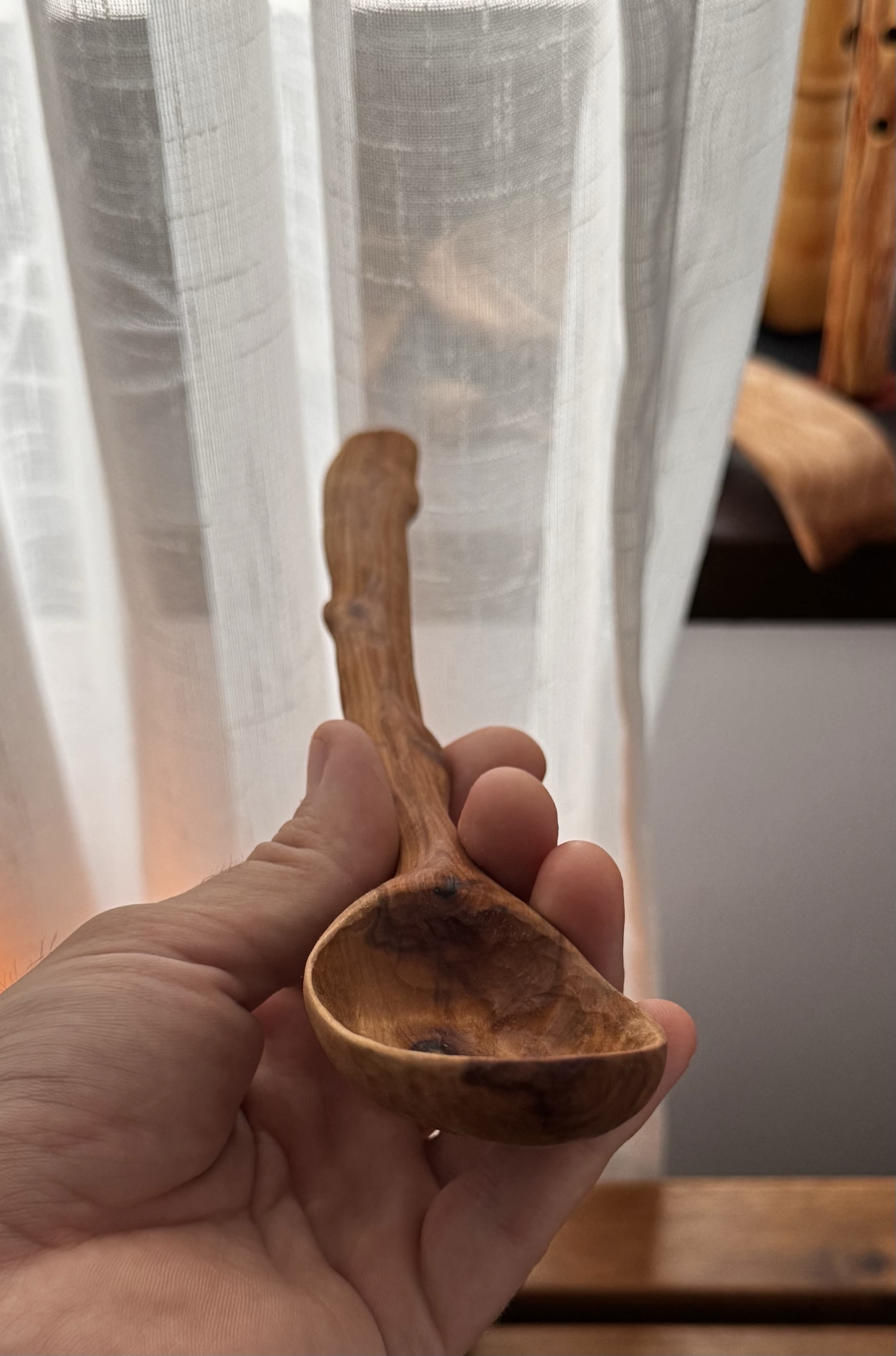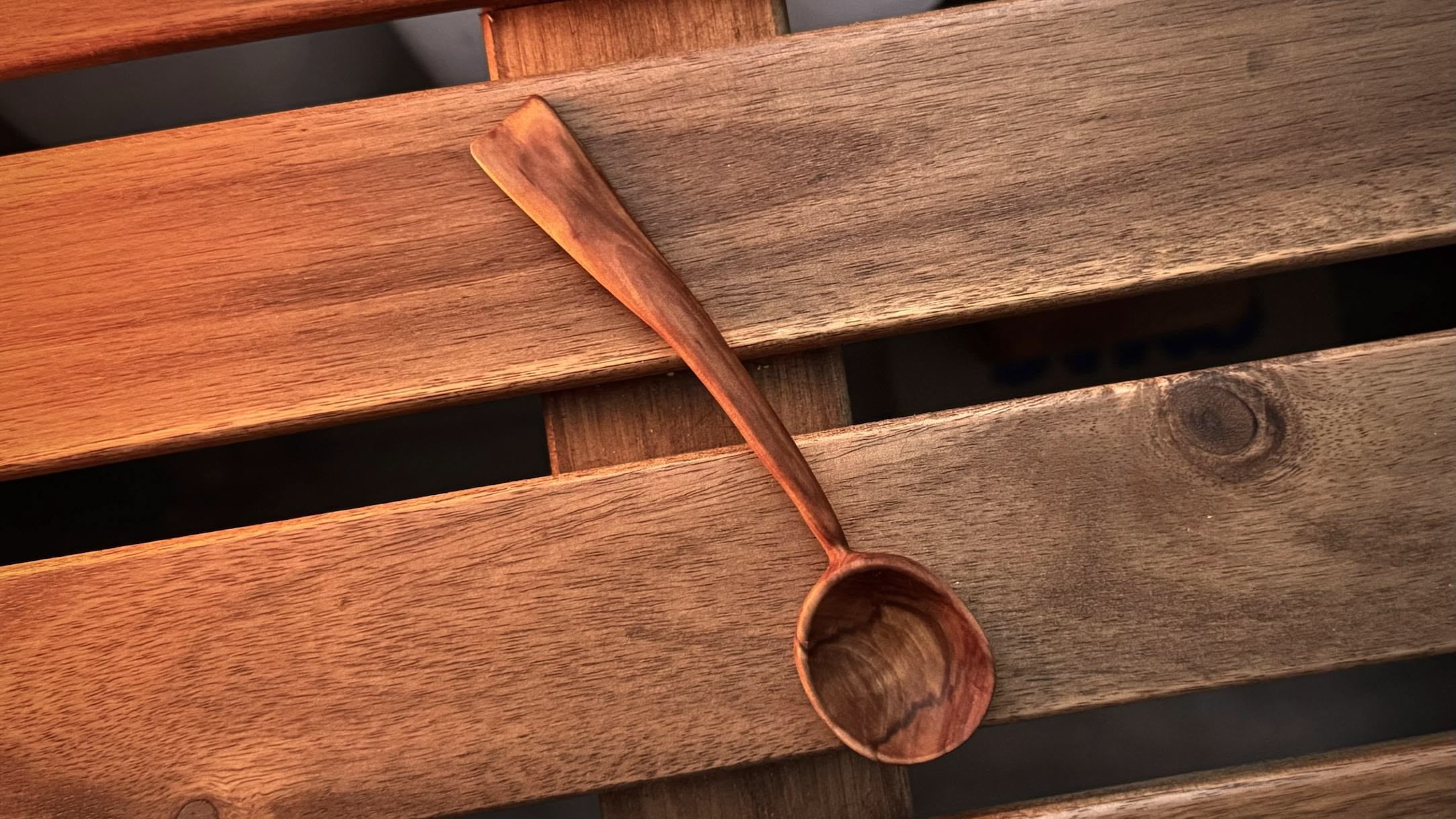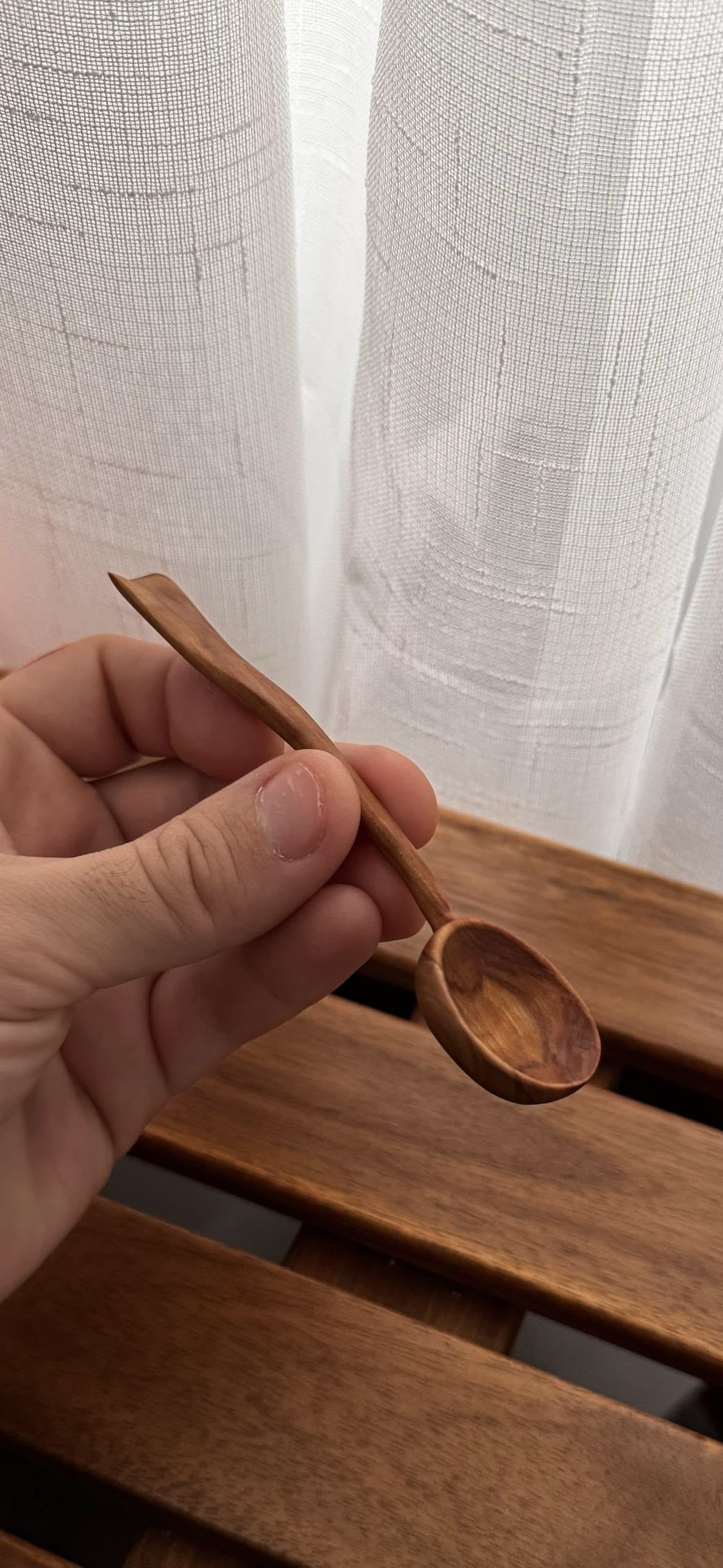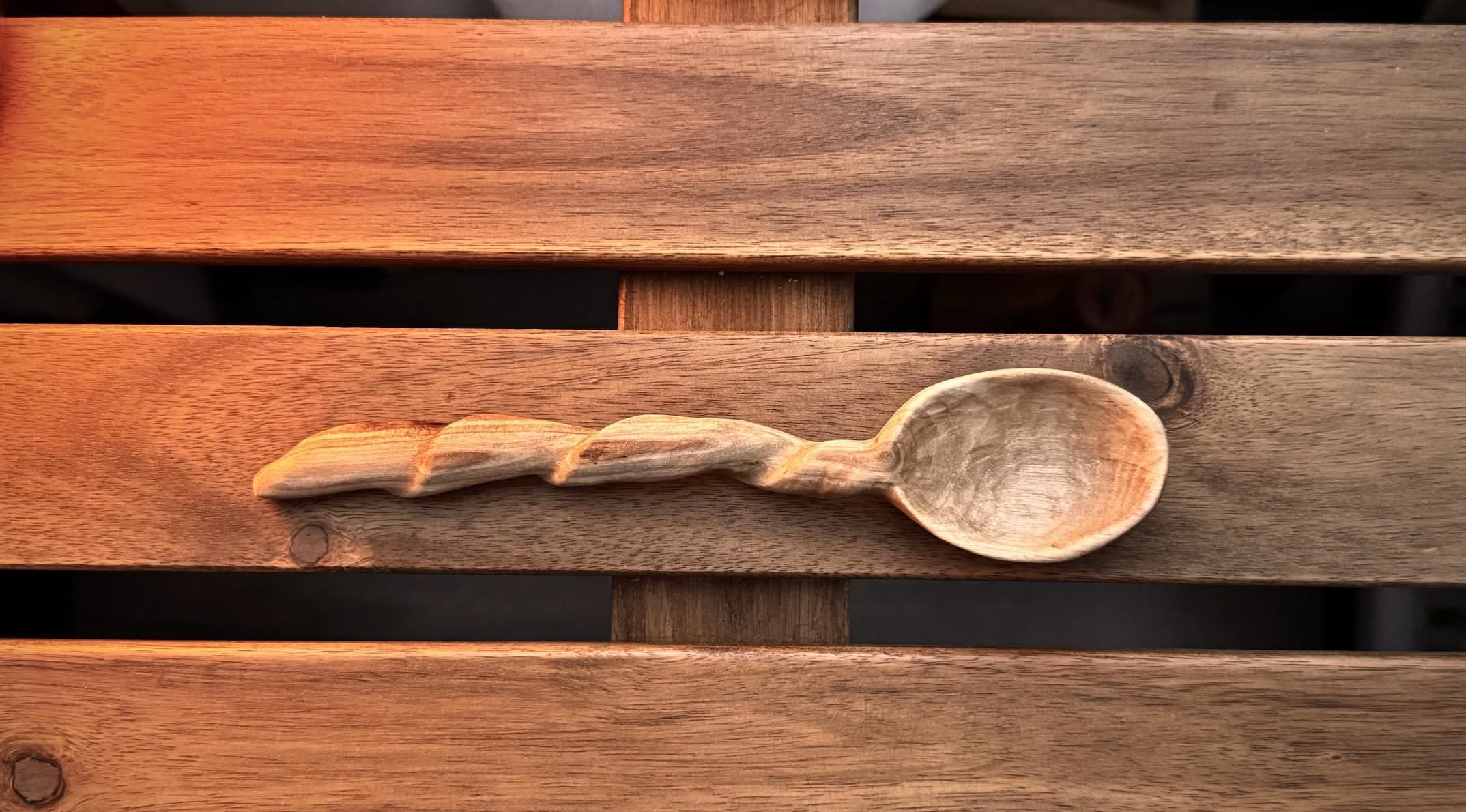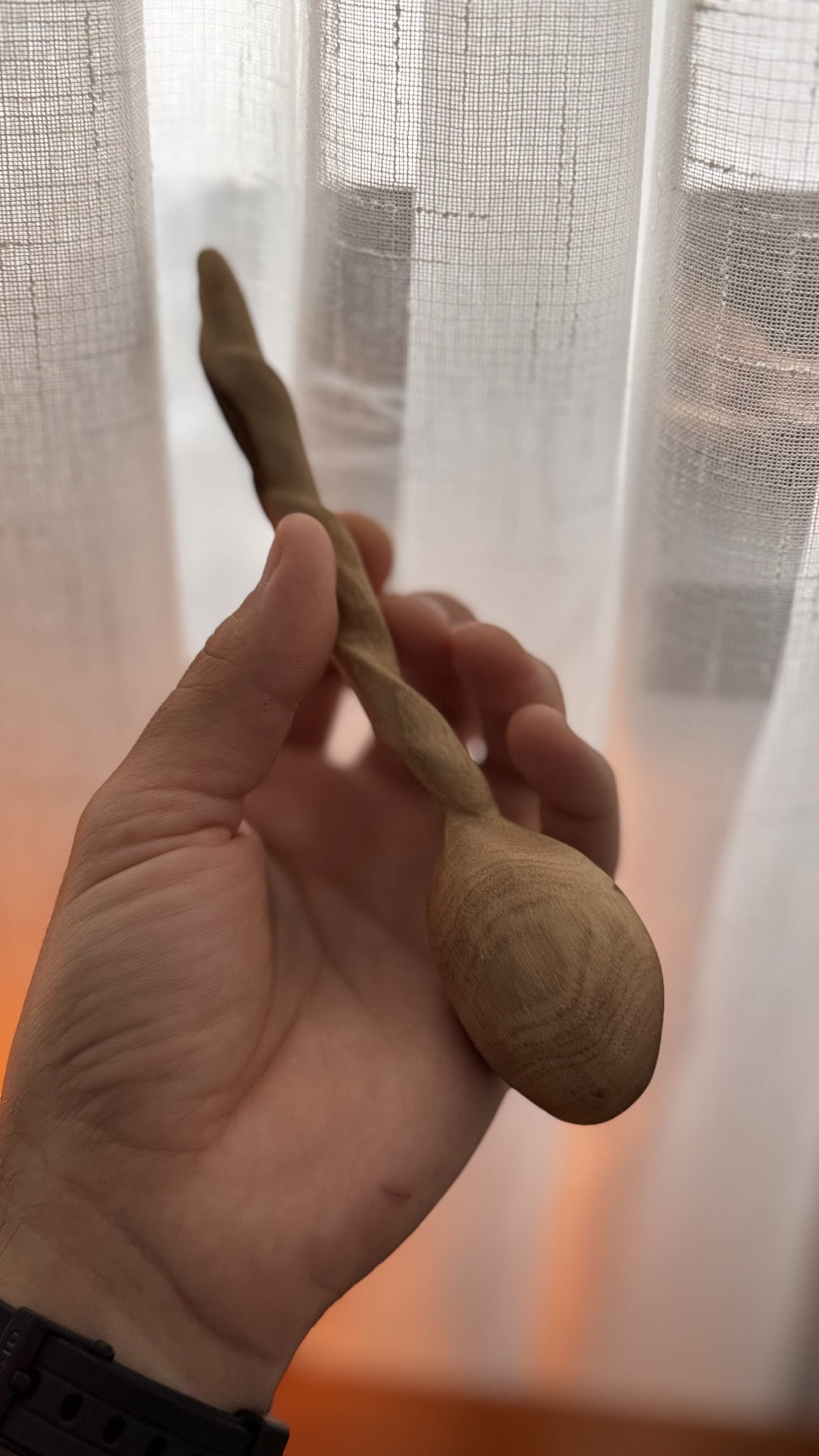my spoon carving journey
# curvy spoon
2024-05-06
Carved a little spoon for my espresso coffee cup, first time I’m doing spoons, but I managed to do it all from a small piece of a walnut branch and my pocket knife.
I finished it with sesame oil to give it a little orange tint because the walnut branch was too white. I also carved my signature logo for the first time, kinda hard to do with a simple pocket knife.
Unfortunately the next day I left the spoon on the table and my dog was alone in the room with it. I heard a crack and when I came into the kitchen, there was only a pool of drool on the table. Part of the spoon handle was between Cora’s front paws and she was happily gnawing on it.
# chunky spoon
2024-05-11
I started another spoon from a stick I found in the forest of the Buciumeni monastery. I believe it’s ash or hornbeam.
Unfortunately I made it too short so I thought I should throw it away.
I finally got the idea that I could glue up a pine stick to make it longer and usable because I really like the wood. I used Poxipol (some kind of epoxy resin glue) because it’s all I had around at my in-laws home. I think I could make this two-tone wood work nicely :)
And here it is, sanded and finished with Osmo Polyx clear hardwax oil. Looks like one of those cigarette holders from Breakfast at Tiffany’s
I used it for the first time this morning and it feels nice for mixing sugar and milk in a small espresso glass. I like how it doesn't make any cling sound when it hits the glass walls. It's a bit too feathery light though, I'll try a denser wood next time to get a heavier spoon.
# something between a spoon and a teaspoon
2024-06-18
1st attempt
This hybrid of a spoon is something my wife wanted for tasting. We went on another trip to Buciumeni to see the flowering of the linden trees and collect some flowers for tea.
On the way back, on the side of the road there was a linden tree with a broken branch. I tug on it and took it down and brought it home with me.
I started this spoon out of that linden branch, which carves like butter indeed. But it’s such a soft wood that it snapped in the weakest spot.
I started another spoon, this time by doing the scoop first.
This one was a success, kinda. It still snapped while finishing it, but I was able to glue it back with CA glue and wrap the joint with epoxy putty to avoid snapping in the future.
Not the prettiest, it will probably sit in the coffee grounds jar. I’ll have to find a denser wood for my wife’s spoon.
2nd attempt
I found an old and very dry black locust branch behind one of the dogs’ house. It didn’t look too promising but I knew locust wood is very dense so I thought I’d give it a try.
It had some knots and cracks and shaping the wood dulled my knives very fast. The hook knife was no match for it. I eventually had to do the scoop with a power drill in a dangerous motion of pushing diagonally into the wood.
I slipped the drill and cut a finger pretty badly, but the spoon turned out really nice :) worth the blood loss
It is still my wife’s favorite spoon so far.
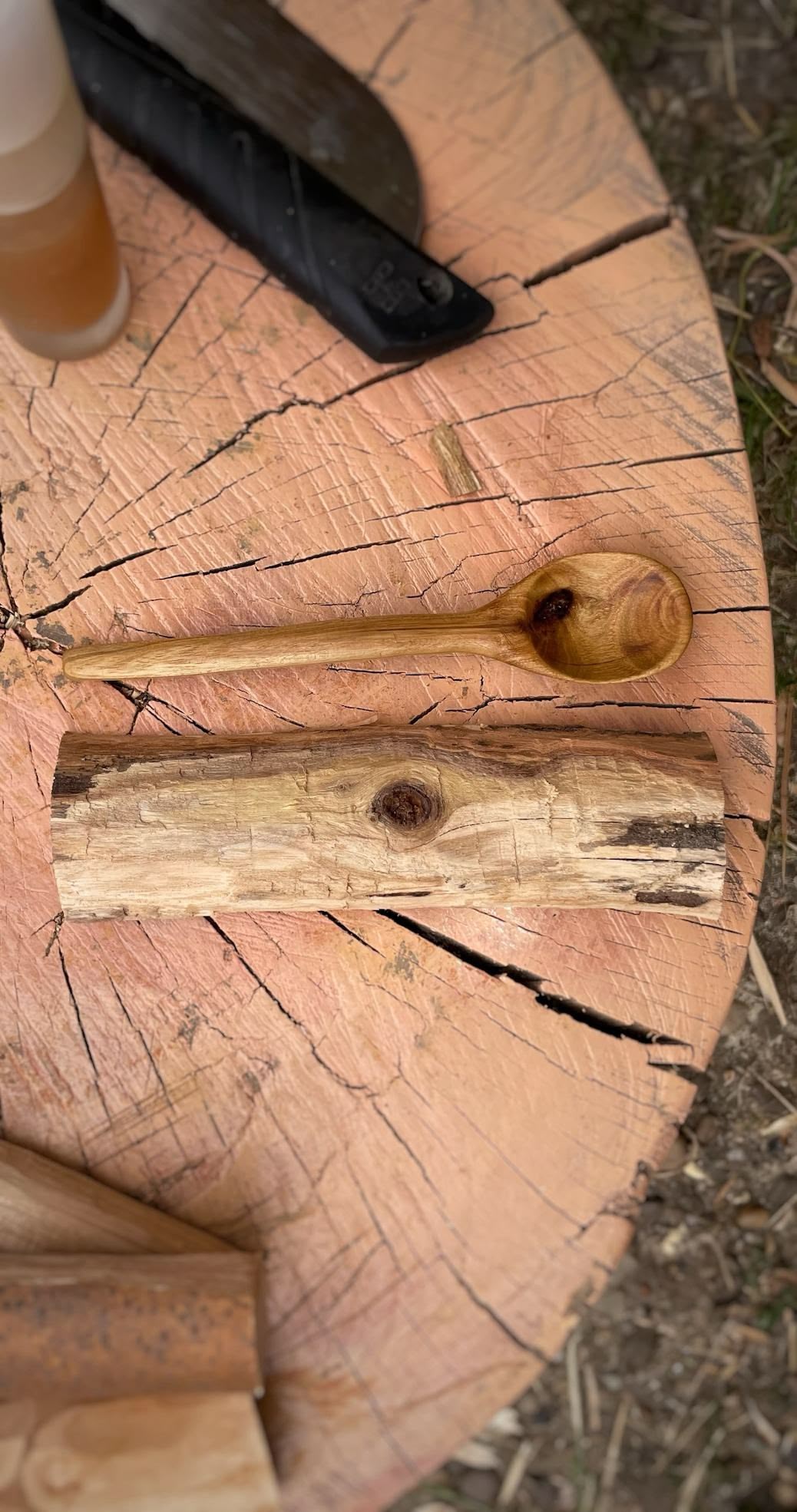
# condiments spoon
2024-07-13
I tried a new drill for making caval flutes out of branches and it turned out to be worse than the long auger bit I used before. The locust branch split after just a few centimeters of drilling.
I cut the split part and thought the half hole looks kind of like those spoons for condiment jars. So I carved one of those spoons out of it.
The coloring of the wood is pretty wild and messy, it looks kind of dirty, not exactly to my taste. But it's a useful spoon, it will probably turn very yellow soon anyway since it will sit in the turmeric jar.
# snaky spoon
2024-07-13
I had a mulberry spoon blank stashed from when I made the black locust spoon. I stored it on a low shelf where my dog was constantly finding and stealing it to gnaw on it when she was bored, so I finally started carving it.
The wood was denser than I expected and I had a lot of material to work with, so I had this idea of making a snaky handle.
Cutting those curves was incredibly hard even with a shaving sharp knife, I ended up using my Dremel with a 430 sanding band bit to finish the curves. This tool is incredibly useful for spoons, I should get one of those fine teeth carving bits.
I didn't really enjoy the dust and the constant noise and the vibration and heat it produced while holding the Dremel, I much prefer the calm and silent carving knife, but it sure helped.
# peach spoons
2024-08-26
This year the peach tree was so fruitful that a branch collapsed and broke under the weight of the peaches. I was there when it happened, so I had the chance to collect the straightest parts of the branch to make spoons out of them.
I had no idea how peach wood behaves but carving it while it was green was very easy, and it dried dense enough to not crack.
It’s the first time I was able to do the spoon cups with the hook knife only, and even get them smoother than I would do with a Dremel or by sanding.
The family of my wife was visiting from Italy so I carved 4 spoons, one for each child plus one for their mother. They seemed most excited about the carved letter of their name on each spoon, but I really liked how they turned up.
Peach wood has contrasting whites and browns which look great after finishing with walnut oil and bees wax.
# wax cherry spoon
2024-09-25
Wax cherry trees are very common here in Romania, it was one of the only fruits I had to eat when I was a child. We ate the fruits green with salt, we ate them sour-sweet right before riping and we still had tons of fruit remaining when they got mellow and sweet. Our dads made palinka out of the remaining fruits, a highly alcoholic clear beverage, with a yellowish tint and weird smell.
That’s why I’m probably sick of the fruit now, but I never thought I could do something with its wood. I had a thick branch that I got from the side of the road here in Brasov, I kept it in the corner of the room because I liked its orange accents after peeling off the bark. It also kinda looked like a deer.
After a few months it cracked in every way possible so I thought about doing another spoon for my wife. She wanted an unusual design: round bottom and flat top of the stem with a sharp scoop.
I’m getting better and better at sharpening and using my hook knives, I was able to get a smooth scoop even with a very dry wood. The trick is to get a very low angle between the blade apex and the wood so that you only take very fine shavings, and cut across the grain to avoid tear out.
Sanding with 400 grit and a coat of tung oil was all this spoon needed for a nice orangey color.
# Red leafed maple spoon
2024-10-23
My brother visited from Bucharest today and we went on a long walk through Brasov’s forests. On a hidden path at the foot of the university hill, we found an old large house surrounded by quince and apple trees. Right when we were walking out of the path into the main road, I saw a beautiful red leafed maple with some dry branches that I could reach.
I thought we could spend some of that afternoon making a spoon each so I broke those branches and got them home.
I got a snaky golden spoon out of it, which is more for show than utility as it has a very shallow scoop. The wood was surprisingly easy to work with and its color is a nice golden hue with very subtle brown discoloration.
# Cedar spoon
2024-10-29
I cut an invasive spiky shrub at our old house a few years ago and I got a branch from it to see how the wood looks. I had no idea it’s cedar until I started shaping it with the knife and the unmistakable cedar scent started coming out of it.
It cut super easily and because I wasn’t expecting that, I got a smaller scoop than I wanted because I kept removing too much wood with the axe.
This time, my wife wanted a circle scoop and a very long handle and I got quite a nice piece. But because the scoop is too small, I have to do another one 😅 her collection of wooden spoons is getting out of hand
And here’s the second attempt: extra long, wider scoop and barely saved out of my dog’s paws
🐾
# Quince spoons
2024-11-16
This is the first time I’m trying to do a knife-only carving, without any sandpaper and power tools. The facets do look nice when you get them right, but I’m still very much a beginner at this.
The wood comes from the same quince tree hill where I got the red leafed cedar. This time I found a half broken large branch on a quince tree which I got home and was immediately surprised how easy it was to cut. It was very green wood for a broken branch.
I really didn’t want to get it so thin, but when cutting, large chunks of fibers would break off. Not sure if it’s not a dense enough wood, or if I should have waited for it to dry a little.
# 2nd attempt
2024-11-23
With the other half of the branch I tried to be slower and get a more unique shape out of it.
There was some black rotten wood on the side and I tried to keep some of it visible so the shape was mostly guided by where that black wood was placed.
I still needed to sand the spoon after finishing the shape as the wood splintered too much in the tight curves. I added some facets afterwards.
Also, the wood is light in color after carving, but it gets dirty very easily, and the end result looks like an old used spoon. To avoid this, I carefully sanded the dirty spots, then dipped the spoon into an espresso to darken it. Finishing with tung oil and wax should keep that color in place.
In the end I got quite a cute pair of quince wood spoons.
# spoon rest
2024-11-24
I've got some old beech floor slabs that have some wild grain variations and I wanted to try and use them for something. My mom asked me to make her a spoon rest when I first started carving, but that was way out of my skill set at the time. I thought I could probably handle that now.
Here's a video of two slabs; one is finished with my beeswax, cocoa butter and walnut oil blend and you can see just how much darker it gets.
I glued three slabs together to make something wide enough for a spoon rest, cut the sides of the handle, then glued one of the scraps to the bottom end of the handle to make a curved and raised handle.
I shaped the bowl with my new Mora 163 knife which I absolutely love. It's so much easier to do push cuts with a double edged blade. It's also much easier to cut my finger really deep, took me a while to find what to wrap around the blade bottom end to avoid that.
The spoon rest handle and general shape was made with an aggressive sanding disc, the beech is very dense and bone dry and it's really hard to shape it manually with a blade. I then sanded it with 180 grit by hand to get it smooth.
I stropped the Mora knife to get it as sharp as possible and did a last push cut pass inside the spoon rest scoop to get some facets. I am starting to like the carving pattern look.
# plum spoons
2024-12-06
While exploring another hill under the university building, one morning, I noticed one of the plum trees had been struck by lightning the night before and fell down. The part of the core where the lightning struck was already rotten and mostly eaten by bugs but most of the tree was still green.
I found a thick broken branch near the tree and got it home. I find it amusing and heartwarming that people in this city never look weird at a guy dragging long soggy branches through main streets.
The wood was surprisingly dense, but weirdly, very easy to carve. It has a golden white sapwood on the sides with a dark red heartwood in the middle. I would have loved to keep the sapwood for light colored accents but the heartwood was quite thick.
# large cooking spoon
The first thing I made from the branch was a large-ish cooking spoon. It was a crooked part of the branch with a gnarly knot, but I tried my best to follow its natural shape instead of forcing a straight spoon out of it.
# small comet spoon
From a smaller part of the branch, I got a small spoon in a shape resembling a comet.
The shape is mostly an accident because of a misplaced hatchet strike while roughing out the shape. But it turned out ok, and it's surprisingly heavy for the size.
# odd walnut spoon
This is not from the plum branch but it's the from the same hill. My dog found some odd walnuts and brought them to me to take home. She likes to play with them a bit on the carpet, then proceeds to crack them open with her teeth and eat the small bits of walnut.
I never saw this walnut shape before, so I thought the wood might be interesting too. I found a dry and half rotten branch to carve a spoon out of it.
The wood color and grain was not that interesting however, it had this dull greenish white color and rough texture no matter how much I sanded it. So I tried to compensate with the shaping.
# olive spoon
2025-03-20
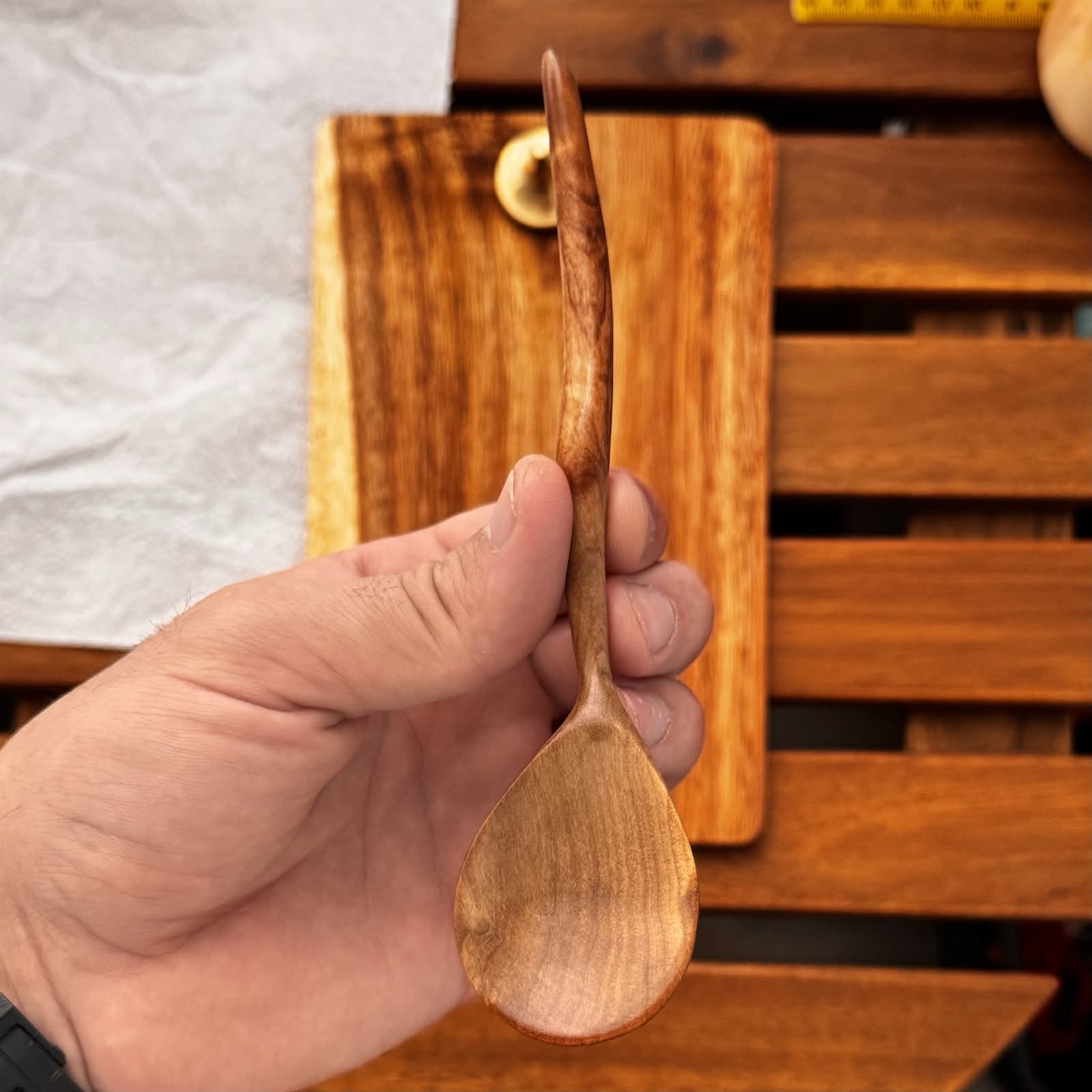
Last winter I went to a flea market to try and sell some of my wooden tool creations like the sharpening blocks and some hammers. I didn't sell much, I don't think I made more than what I paid on the taxi to the market and back home.
But at some point an experienced woodworker approached me and bought one of the sharpening blocks, and invited me to his shop so I can see this very old olive tree that he recently bought for making tables.
I finally found time to pay him a visit in March and he gifted me a nice block of olive wood.
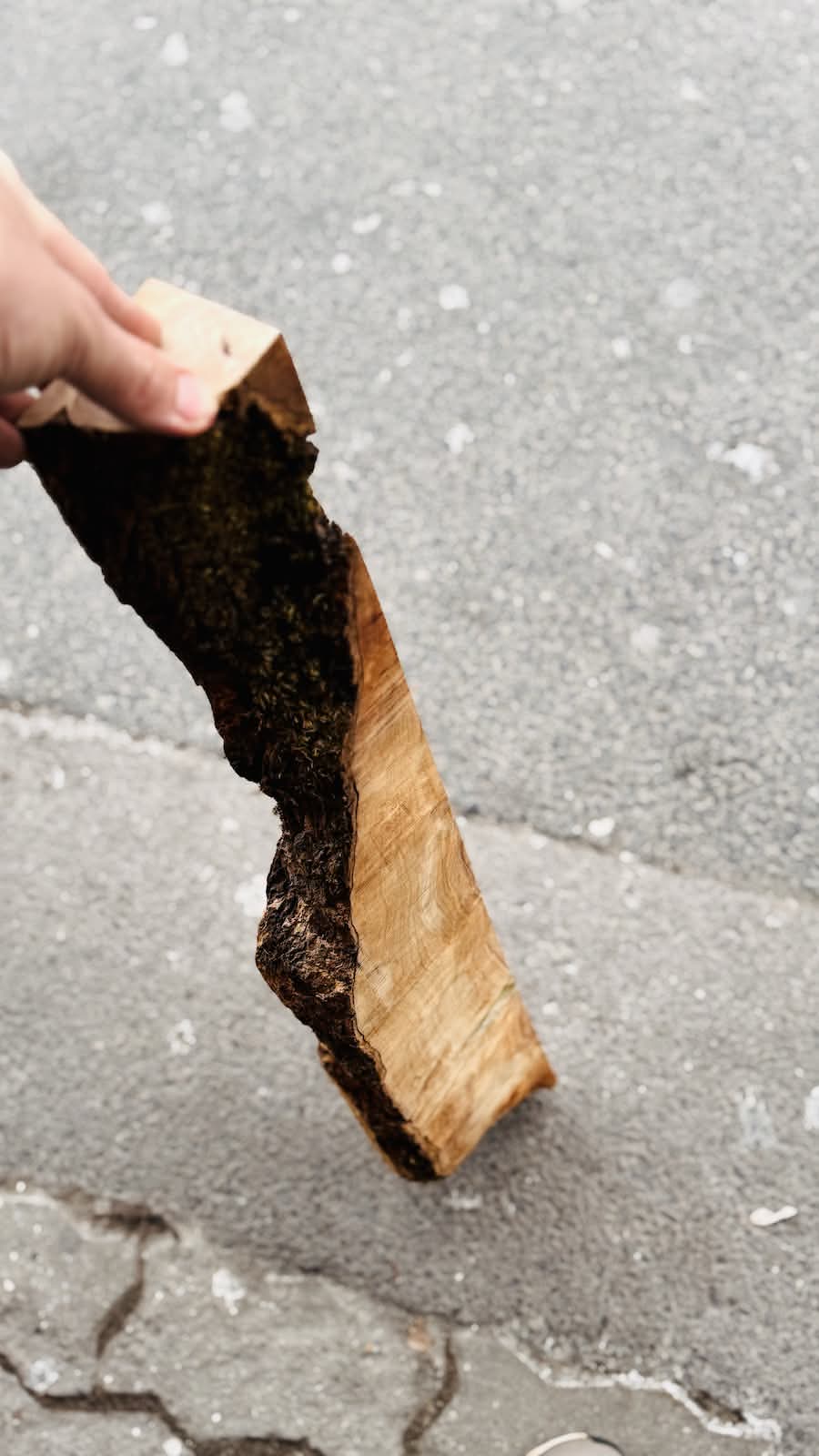
The first thing I did out of it is this olive spoon in the picture above, I really like its shape and sheen. The wood is very dense and dry so it's unworkable with knives, but I recently got some carbide carving discs for my angle grinder which shaped the wood really easy.
The bowl of the spoon was still done with the hook knife, it was hard but the best choice for getting a good shape and finish.
I had some leftover cutoffs so I cleaned up the largest of them and made a nice salt holder to keep above the stove so we can always reach for the salt when cooking.
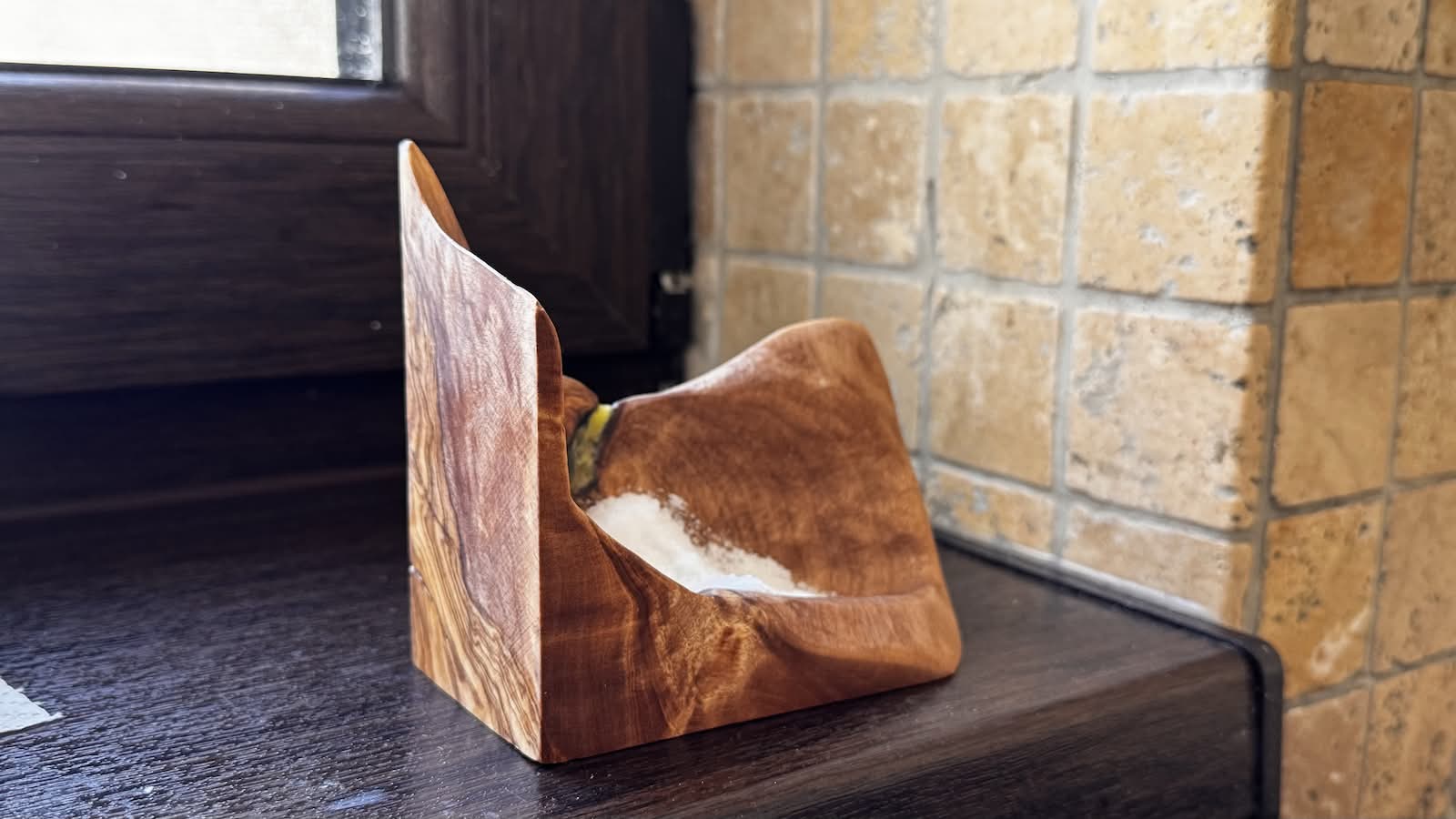
# plum cooking spoon
2025-04-04
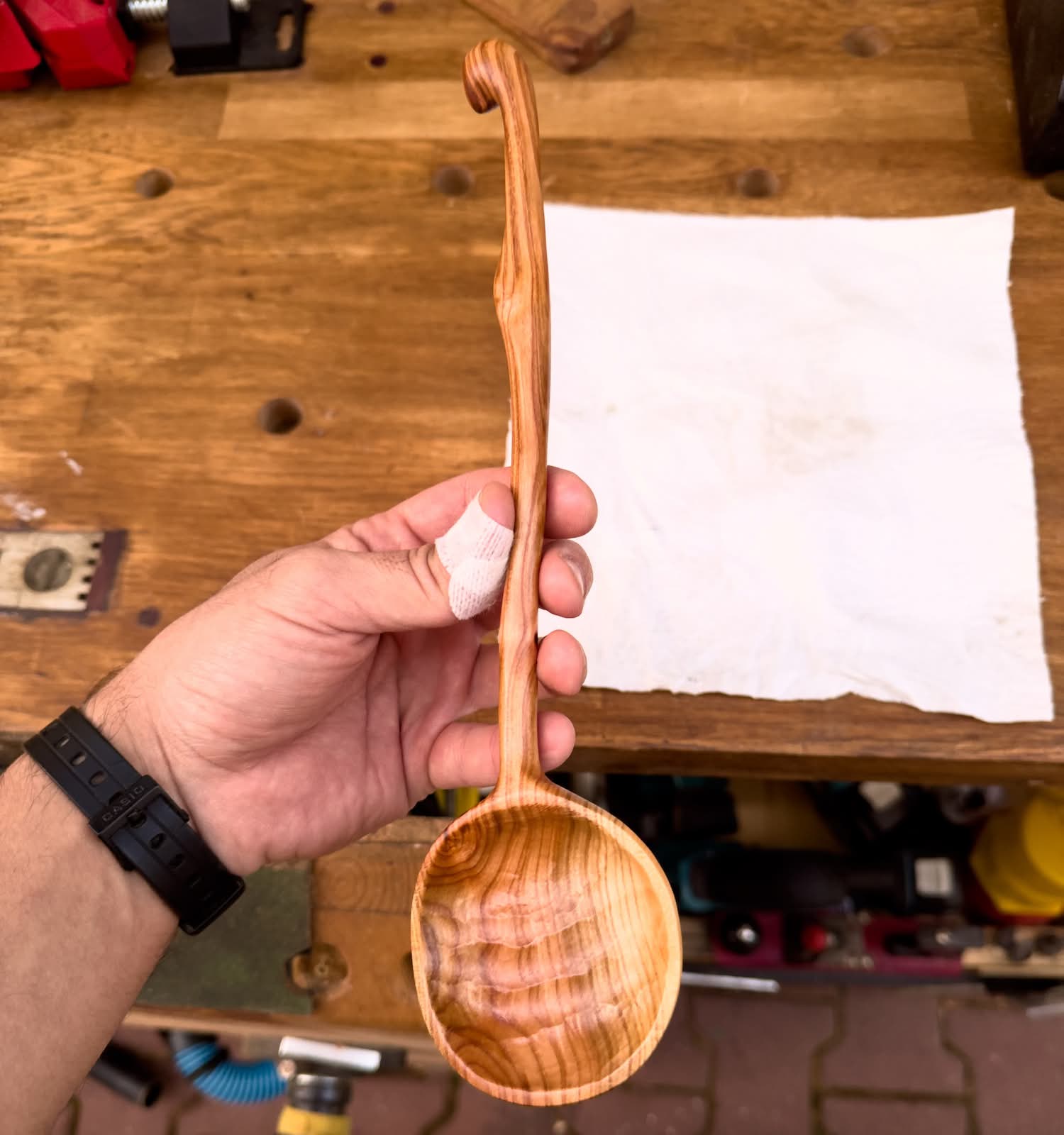
It’s that time of year when the nearby trees are pruned and thick branches are left on the side of the road.
I picked some plum tree thick branches to make some coffee cups but unfortunately the wood cracks too easily and develops checks so I carved some spoons instead.
This is a large cooking spoon, done with the usual Mora 163 double edge hook knife and the Mora 120 carbon knife, finished with the DIY food-safe hardwax oil from Workshop Companion’s recent video
The wood is not pleasant to carve, as it’s very dense while also splitting too easily. But it does get an incredible sheen just from the knife cutting the fibers.
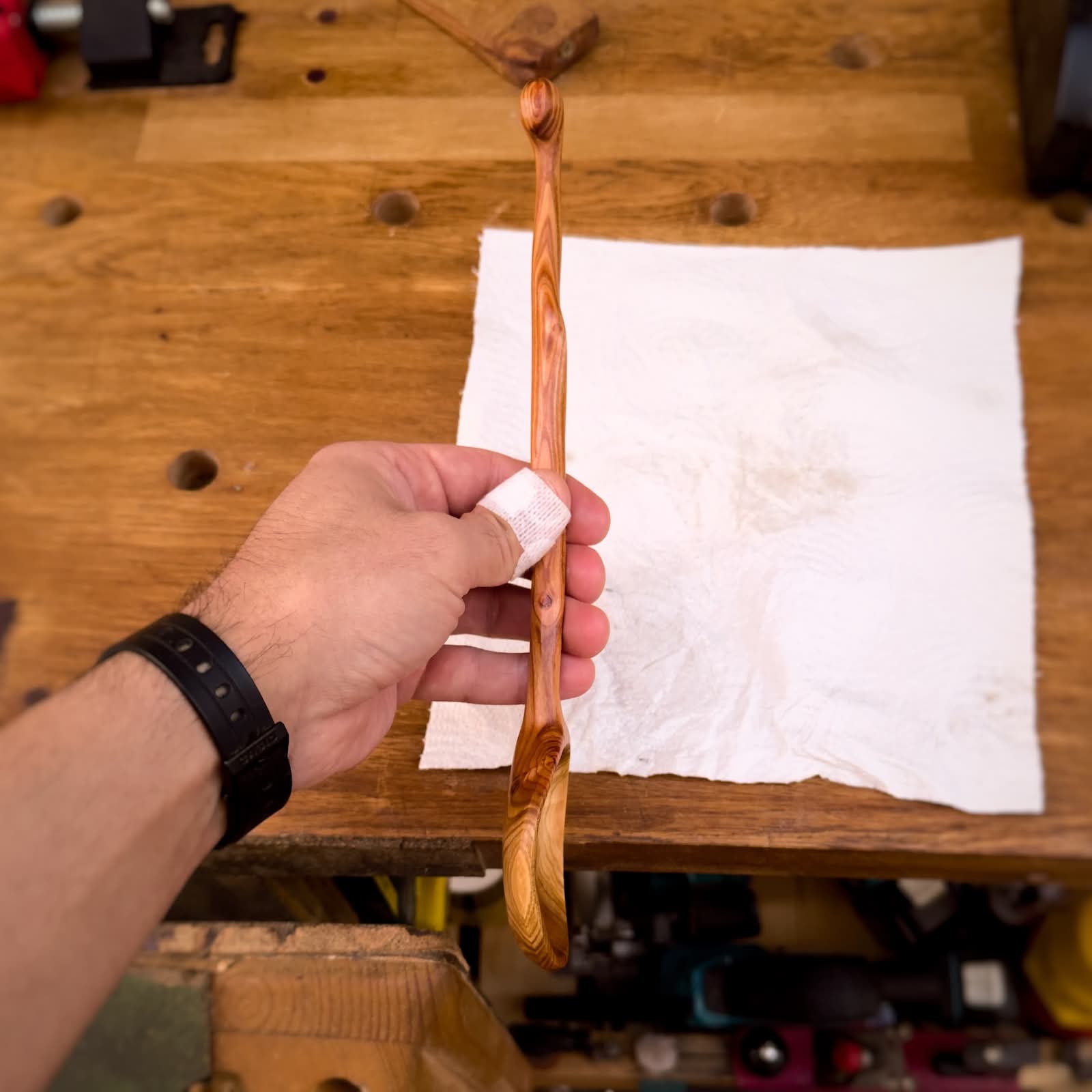
# sycamore coffee spoons
2025-04-05
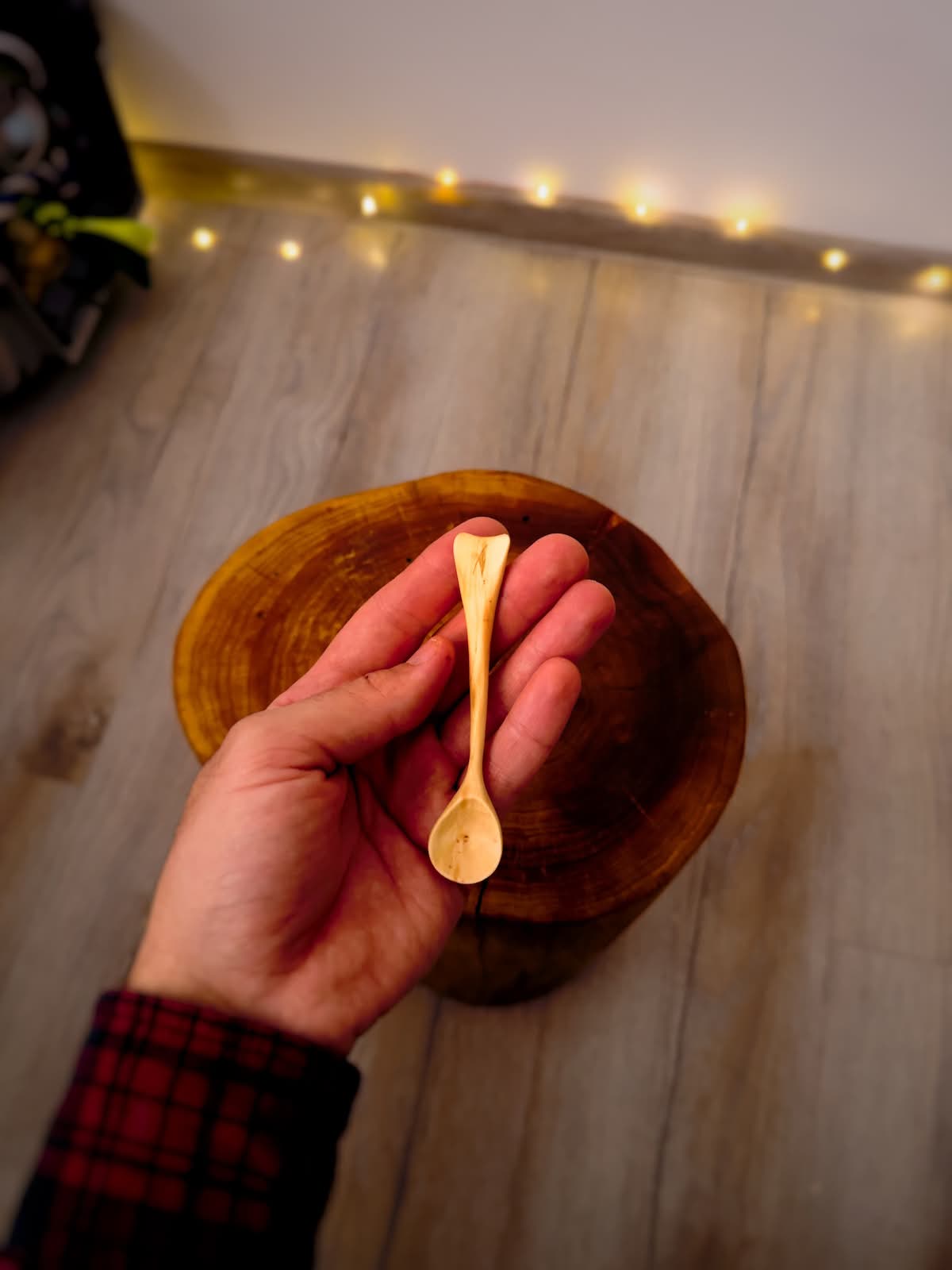

I’m trying to open an online shop where I can sell some of my creations, and I thought to start with some of my favorite type of spoons: tiny and thin coffee mixing spoons.
I made these out of a sycamore branch I got from a hike last year. Lovely wood for carving, and ages into a beautiful light-gold color with warm brown accents.
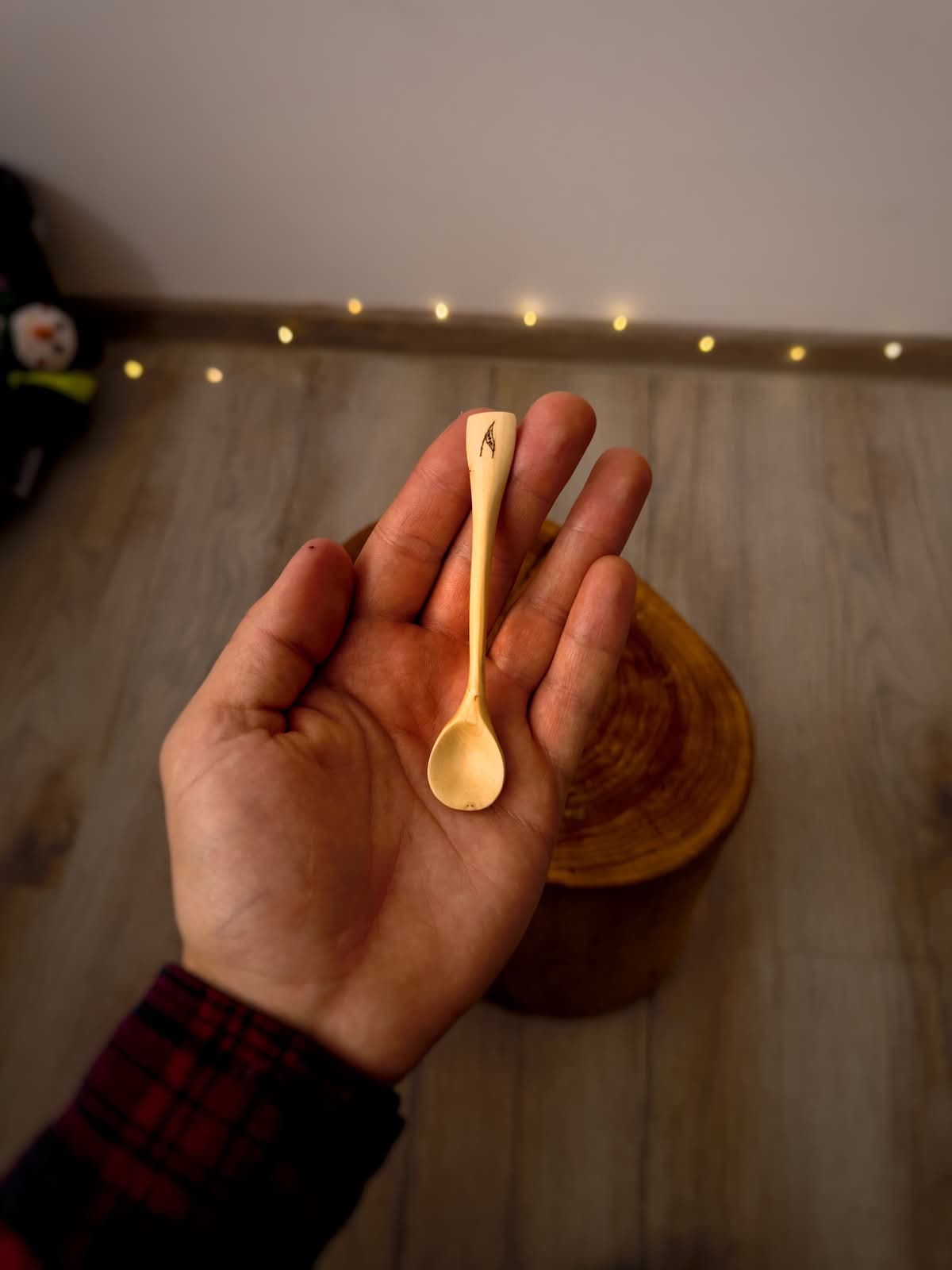
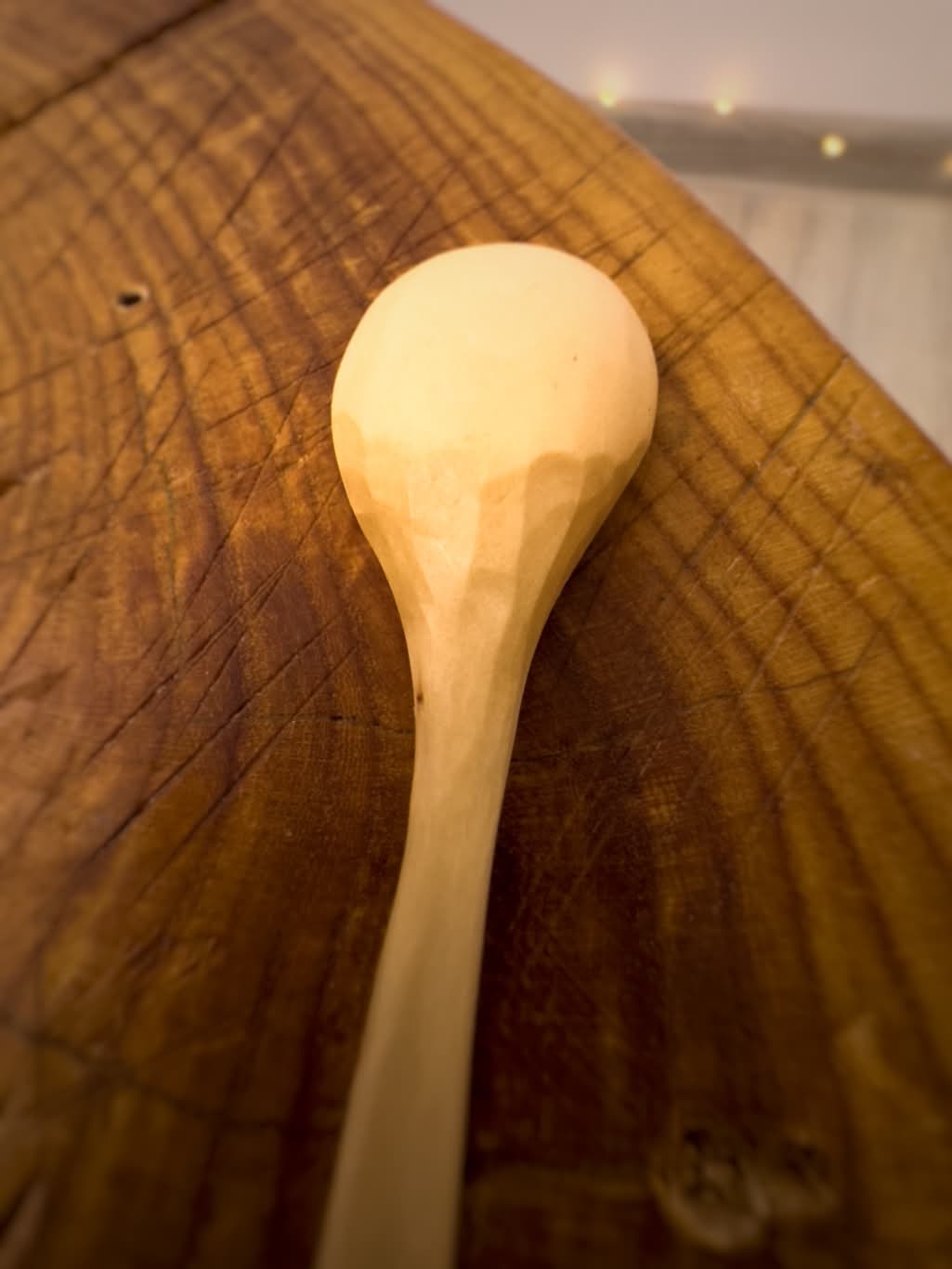
The aged color can be best seen in these salt shakers I made last year.
